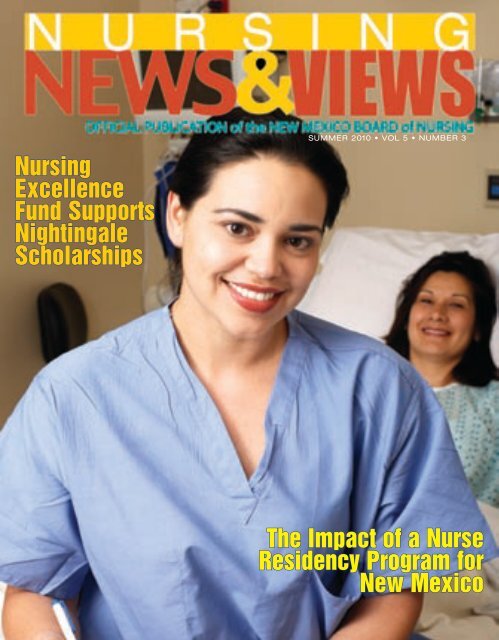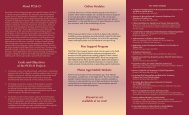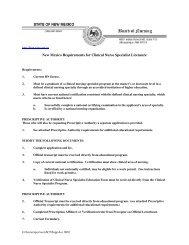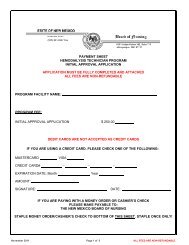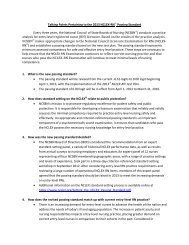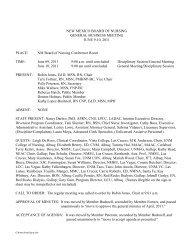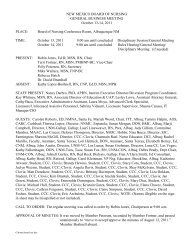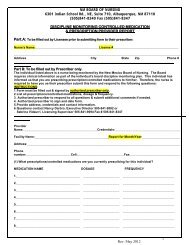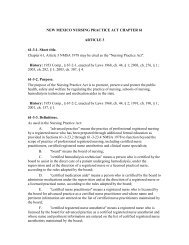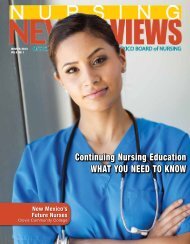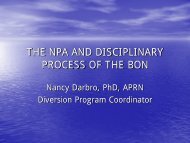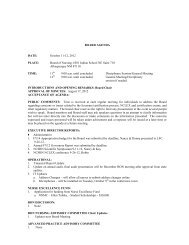Newsletter Summer 2010 - the New Mexico Board of Nursing
Newsletter Summer 2010 - the New Mexico Board of Nursing
Newsletter Summer 2010 - the New Mexico Board of Nursing
Create successful ePaper yourself
Turn your PDF publications into a flip-book with our unique Google optimized e-Paper software.
<strong>Nursing</strong>ExcellenceFund SupportsNightingaleScholarshipssummer <strong>2010</strong> • Vol 5 • Number 3The Impact <strong>of</strong> a NurseResidency Program for<strong>New</strong> <strong>Mexico</strong>
A great nurse can have a great impact on <strong>the</strong> patients <strong>the</strong>y serve. Memorial Medical Center is lucky tohave a passionate and experienced team <strong>of</strong> nurses. Many <strong>of</strong> our nurses, including <strong>the</strong> ones seen here,have spent over 20 years at MMC caring for <strong>the</strong> health <strong>of</strong> our community. We thank all <strong>of</strong> our nurses for<strong>the</strong>ir skill and <strong>the</strong>ir commitment to <strong>the</strong> community, and above all—<strong>the</strong>ir passion for helping o<strong>the</strong>rs.Las Cruces, NM • mmclc.org • (575) 521-2230
Contents <strong>Summer</strong> <strong>2010</strong>Message from <strong>the</strong> <strong>Board</strong> <strong>of</strong> <strong>Nursing</strong>Chair .............................4Disciplinary Action................7The <strong>New</strong> <strong>Mexico</strong> <strong>Board</strong> <strong>of</strong><strong>Nursing</strong> ..........................8Grounds for Action ...............10Partnerships in <strong>Nursing</strong>Education .......................12The Impact <strong>of</strong> a Nurse ResidencyProgram for <strong>New</strong> <strong>Mexico</strong> .........13<strong>Nursing</strong> Excellence Fund SupportsNightingale Scholarships .........15Diversion Program DischargeLetter ...........................16Did you Know?...................17Diversion Program Update ........18<strong>New</strong> Model for Advanced Practice<strong>Nursing</strong> .........................21<strong>Nursing</strong> Practice Act and RulesCurrently in Effectedition 20• NPA, 6-14-91, and 1994, 1995, 1997, 2000, 2005,2006 and 2008 amendments.• Rules 16.12.1 NMAC, Amended 5-17-10The amendments and/or rules are available on ourWeb site or by calling <strong>the</strong> <strong>Board</strong> <strong>of</strong>fice.Created byPublishing Concepts, Inc.Virginia Robertson, Publishervrobertson@pcipublishing.com14109 Taylor Loop RoadLittle Rock, AR 72223501.221.9986For advertising information contact:Don Grant at 501.221.9986 or 800.561.4686 ext.106dgrant@pcipublishing.com<strong>Board</strong> Staff and Direct NumbersDeborah Walker, MSN, RN,Executive Director – 841-9082Cathy Baca, ExecutiveAdministrative Assistant –841-9085Nancy Darbro, Ph.D., APRN,CNS, Diversion ProgramCoordinator – 841-8345Mary Messinger, LADAC, AAS,Diversion Program CaseManager – 841-9091Tani Skinner, BSN, RN,Chief Nurse Investigator –841-9055Daniel Griego, AgencyAdministrator– 841-8344Vicki Vehar, Financial Specialist III –841-9086Shauna Casaus, IT Manager/CIO – 841-9061Ernestine Garcia-Simpson,Advanced Clerk Specialist(Diversion Programs) – 841-9093The <strong>New</strong> <strong>Mexico</strong> <strong>New</strong>s & Viewsis published quarterly by <strong>the</strong> <strong>New</strong><strong>Mexico</strong> State <strong>Board</strong> <strong>of</strong> <strong>Nursing</strong>.Each issue is distributed toevery actively licensed LPN, RN,APN, certified medication aides,and hemodialysis technicians,as well as to nurse employers,and nurse educators. Nurses,students, and pr<strong>of</strong>essionals fromhealthcare organizations turn tothis publication for updates onclinical practices, informationon government affairs initiatives,to discover what best practicesare being implemented, andfor insight into how healthcareproviders are facing today’schallenges.ContactInformationfor <strong>the</strong> <strong>New</strong><strong>Mexico</strong> <strong>Board</strong> <strong>of</strong><strong>Nursing</strong>OFFICIAL PUBLICATION <strong>of</strong> <strong>the</strong> NEW MEXICO BOARD <strong>of</strong> NURSINGMission Statement: “Protect public safety through effective regulation <strong>of</strong> nursing care and services.”Vision Statement: “Excellence in Regulatory Practice.”Strategic Goals: • Advance <strong>Nursing</strong> Systems• Maximize Effectiveness in Public Protection• Maximize Effectiveness in Customer ServiceBridget Padilla, Advanced ClerkSpecialist (Criminal BackgroundChecks) – 841-9059Emily Gurule, Advanced ClerkSpecialist (Renewal/Verifications) –841-9089Johnny Romero, AdvancedClerk Specialist (Endorsement/Examination/Advanced Practice) –841-9088Sabrina Vidaurri, Advanced ClerkSpecialist (Discipline/Complaints) –841-9094Laura Moya, Advanced ClerkSpecialist (Unlicensed AssistivePersonnel) – 841-9049Felicia Cordova, Receptionist –841-9056Please continue to call <strong>the</strong> main numberat (505) 841-8340 or visit ourWeb site: www.bon.state.nm.us to verifylicenses and to check if <strong>the</strong> nurse’slicense is current. If you need to e-mailus, please click on Contact Form onour home page and <strong>the</strong>n click on <strong>the</strong>drop down box and pick whichevercategory you need assistance with.<strong>New</strong> <strong>Mexico</strong><strong>New</strong>s & Views’circulation includesover 26,000 licensednurses and studentnurses in<strong>New</strong> <strong>Mexico</strong>.Address Change? NameChange? Question?In order to continue uninterrupteddelivery <strong>of</strong> this magazine, pleasenotify <strong>the</strong> <strong>Board</strong> <strong>of</strong> any change toyour name or address. Thank You.<strong>New</strong> <strong>Mexico</strong> <strong>Board</strong> <strong>of</strong> <strong>Nursing</strong>6301 Indian School Rd. N.E., Suite 710Albuquerque, NM 87110phone (505) 841-8340 fax (505) 841-8347Web site: www.bon.state.nm.us<strong>Board</strong> MembersPolly Petersen, RN, Secretary –Dona Ana County –Term: 07/01/12Terri Fortner, RN, MSN, PMH-NP,<strong>Board</strong> Chair – San Juan County –Term: 05/30/11Kathleen Lopez Bushnell,Bernalillo County –Term: 07/01/14Mike Wallace, MSN, FNP-BC,Bernalillo County –Term: 07/01/13Robin Jones, Ed.D, MSN, RN,Vice-Chair – Curry County –Term: 07/01/12Denton Holmes, Public Member –Dona Ana County –Term: 07/01/11Diale Fomukong, M.Sc., CEDFP,Public Member – BernalilloCounty – Term: 07/01/13SubmissionsScholarly and informative itemsdealing with health care topicsand issues are welcome. Contact<strong>the</strong> <strong>New</strong> <strong>Mexico</strong> State <strong>Board</strong> <strong>of</strong><strong>Nursing</strong> at <strong>the</strong> address below.SubscriptionsEach new issue <strong>of</strong> <strong>New</strong> <strong>Mexico</strong><strong>New</strong>s & Views is available forviewing on <strong>the</strong> <strong>New</strong> <strong>Mexico</strong><strong>Board</strong> Web site. To request afuture issue to be mailed to you,contact <strong>the</strong> <strong>New</strong> <strong>Mexico</strong> <strong>Board</strong><strong>of</strong> <strong>Nursing</strong> at <strong>the</strong> address below.<strong>Nursing</strong><strong>New</strong>s&Views3
National Council <strong>of</strong>State <strong>Board</strong>s <strong>of</strong> <strong>Nursing</strong> <strong>New</strong>sNCSBN Raises Passing StandardThe National Council <strong>of</strong> State <strong>Board</strong>s <strong>of</strong><strong>Nursing</strong>, Inc. (NCSBN) voted on Dec. 10, 2009,to raise <strong>the</strong> passing standard for <strong>the</strong> NCLEX-RN Examination. The new passing standard is-0.16 logits on <strong>the</strong> NCLEX-RN logistic scale,0.05 logits higher than <strong>the</strong> previous standard <strong>of</strong>-0.21. The new passing standard will take effecton April 1, <strong>2010</strong>, in conjunction with <strong>the</strong> <strong>2010</strong>NCLEX-RN Test Plan.After consideration <strong>of</strong> all available information,<strong>the</strong> NCSBN <strong>Board</strong> <strong>of</strong> Directors determinedthat safe and effective entry-level RNpractice requires a greater level <strong>of</strong> knowledge,skills, and abilities than was required in 2007,when NCSBN implemented <strong>the</strong> current standard.The passing standard was increased inresponse to changes in U.S. health care deliveryand nursing practice that have resulted in<strong>the</strong> greater acuity <strong>of</strong> clients seen by entry-levelRNs.The <strong>Board</strong> <strong>of</strong> Directors used multiplesources <strong>of</strong> information to guide its evaluationand discussion regarding <strong>the</strong> change in passingstandard. As part <strong>of</strong> this process, NCSBNconvened an expert panel <strong>of</strong> nine nurses toperform a criterion-referenced standard settingprocedure. The panel’s findings supported <strong>the</strong>creation <strong>of</strong> a higher passing standard. NCSBNalso considered <strong>the</strong> results <strong>of</strong> national surveys<strong>of</strong> nursing pr<strong>of</strong>essionals including nursing educators,directors <strong>of</strong> nursing in acute care settingsand administrators <strong>of</strong> long-term care facilities.A PDF <strong>of</strong> <strong>the</strong> <strong>2010</strong> NCLEX-RN Test Plan isavailable free <strong>of</strong> charge from <strong>the</strong> NCSBN Website https://www.ncsbn.org/<strong>2010</strong>_NCLEX_RN_TestPlan.pdf.The definition <strong>of</strong> a logit may be found onNCSBN’s Web site at https://www.ncsbn.org/02_18_05_brief.pdf.NCSBN Wants You!: Participate in Item DevelopmentProgramThe National Council Nurse LicensureExaminations (NCLEX®) are designed to testknowledge, skills, and abilities essential to <strong>the</strong>safe and effective practice <strong>of</strong> nursing at <strong>the</strong> entrylevel. The National Council <strong>of</strong> State <strong>Board</strong>s<strong>of</strong> <strong>Nursing</strong> (NCSBN) recruits qualified nursesto serve on NCLEX-RN® and NCLEX-PN® ExaminationItem Writing and Item Review panelswhich are coordinated by <strong>the</strong> contracted testservice. The process <strong>of</strong> developing one item(question) for <strong>the</strong> NCLEX-RN® or NCLEX-PN®examination goes through multiple steps over a12-18 month period and involves many qualifiedvolunteers to write or review items. Thevolunteers who participate on panels are anintegral part <strong>of</strong> <strong>the</strong> item development process.The qualifications for <strong>the</strong> Item DevelopmentProgram are outlined in <strong>the</strong> following brochure:https://www.ncsbn.org/Item_Development_2009.pdfBenefits to serving on an Item DevelopmentPanel:- All expense paid trip to Chicago.- Contribute to continued excellence in <strong>the</strong>nursing pr<strong>of</strong>ession.- Have opportunities to network on a nationallevel.- Build new skills that are useful in your currentposition as well as for pr<strong>of</strong>essional growth.- Earn continuing education contact hours.If you know <strong>of</strong> nurses who are qualified tovolunteer, please direct <strong>the</strong>m to our Web siteto submit an on-line application at:https://www.ncsbn.org/1227.htm.NCSBN Publishes <strong>2010</strong> NCLEX-RN DetailedTest PlanThe National Council <strong>of</strong> State <strong>Board</strong>s <strong>of</strong><strong>Nursing</strong> (NCSBN) has published <strong>the</strong> <strong>2010</strong>NCLEX-RN Detailed Test Plan and has postedit to its Web site at https://www.ncsbn.org/1287.htm. The purpose <strong>of</strong> this document, which is<strong>of</strong>fered in both an Item Writer/Item Reviewer/Nurse Educator version and a Candidate version,is to serve as a guide for both examinationdevelopment and candidate preparation.Based on <strong>the</strong> test plans, each unique NCLEX-RN Examination reflects <strong>the</strong> knowledge, skillsand abilities essential for <strong>the</strong> prospective RN tomeet <strong>the</strong> needs <strong>of</strong> clients requiring <strong>the</strong> promotion,maintenance and restoration <strong>of</strong> health. TheNCLEX-RN Test Plan is evaluated every threeyears and changes are made based on empiricaldata from a practice analysis, expert judgmentand feedback from member boards. The testplan was approved by <strong>the</strong> NCSBN DelegateAssembly in August and will go into effect onApril 1, <strong>2010</strong>. In addition to <strong>the</strong> NCLEX-RNExamination, NCSBN also develops and administers<strong>the</strong> National Council Licensure Examinationfor Licensed Practical/Vocational Nurses(NCLEX-PN). A total <strong>of</strong> more than 250,000NCLEX-RN and NCLEX-PN Examinationsare administered each year. More informationabout NCLEX examinations can be found on<strong>the</strong> NCSBN Web site www.ncsbn.org, by calling866.293.9600 (toll free) or e-mailing nclexinfo@ncsbn.org.The NCLEX Examination TutorialThe National Council Licensure Examinations(NCLEX) are designed to test <strong>the</strong> knowledge,skills and abilities essential to safe and effectivepractice <strong>of</strong> nursing at <strong>the</strong> entry level. Althoughcandidates who sit for <strong>the</strong> licensure examinationhave successfully graduated from an accreditednursing program, <strong>the</strong>y still <strong>of</strong>ten encounter highlevels <strong>of</strong> anxiety about taking <strong>the</strong> examination.In order to dispel <strong>the</strong> examination fears <strong>of</strong> candidates,it is helpful to encourage a relaxed approachto <strong>the</strong> NCLEX examination. One <strong>of</strong> <strong>the</strong>best ways to ensure this is to familiarize oneselfwith <strong>the</strong> format <strong>of</strong> <strong>the</strong> examination by using <strong>the</strong>full interactive tutorial available on <strong>the</strong> PearsonVUE Web site at http://www.pearsonvue.com/nclex/#tutorial. While <strong>the</strong> content <strong>of</strong> <strong>the</strong> tutorialis not nursing centered, it is a beneficial toolfor increasing familiarity with <strong>the</strong> format <strong>of</strong> <strong>the</strong>NCLEX examinations. It is encouraged thatcandidates utilize <strong>the</strong> tutorial frequently beforetaking <strong>the</strong> examination. Additionally, candidateswill also complete <strong>the</strong> tutorial directly before<strong>the</strong> start <strong>of</strong> <strong>the</strong>ir examination at <strong>the</strong> test center.An awareness <strong>of</strong> <strong>the</strong> examination format willprovide a more relaxed examination experi-<strong>Nursing</strong><strong>New</strong>s&Views5
ence and allow candidates to concentrate on<strong>the</strong> content <strong>of</strong> <strong>the</strong> examination.NCSBN Learning ExtensionThe National Council <strong>of</strong> State <strong>Board</strong>s <strong>of</strong><strong>Nursing</strong>’s Learning Extension has been relaunchedas a virtual community! Your courseaccess is still only a click away—just go to www.learningext.com and click “Enter Online Campus.”Join <strong>the</strong> new community in just a feweasy steps: 1. Select <strong>the</strong> group that is <strong>the</strong> bestfit for you (Students community, Nurses community,or Faculty community for nurse educators).Set up a pr<strong>of</strong>ile/add a picture, keep track<strong>of</strong> your posts, comments and subscriptions, goto Navigating My Pages (under My Home) tolearn how to use <strong>the</strong> new capabilities. ContactNCSBN Learning Extension via email atelearning@ncsbn.org; phone at 312.525.3749(M-F 9:00-5:00 CT); or visit <strong>the</strong> web address:www.learningext.com.Book for foreign educated pr<strong>of</strong>essionalsA primary resource for foreign-educatedallied health pr<strong>of</strong>essionals has just been publishedby CGFNS International and SpringerPublishing Company. The Official Guide forForeign-Educated Allied Health Pr<strong>of</strong>essionals,What You Need to Know About Health Careand <strong>the</strong> Allied Health Pr<strong>of</strong>essions in <strong>the</strong> UnitedNCSBN CEO inducted as a Fellow into<strong>the</strong> American Academy <strong>of</strong> <strong>Nursing</strong>ANCC to retire CNSCertification ExamThe American Nurses Credentialing Center(ANCC) will retire <strong>the</strong> Clinical Nurse SpecialistCore certification examination on July 1, <strong>2010</strong>,due to <strong>the</strong> low candidate volume during <strong>the</strong>exam pilot window (September 1 – December31, 2009.) Applications for <strong>the</strong> final cycle <strong>of</strong> <strong>the</strong>exam will be accepted from January 1, <strong>2010</strong>,through February 15, <strong>2010</strong>. Candidates whoapply during this period and are determined eligibleto sit for <strong>the</strong> exam will be assigned a testingwindow between April 1, <strong>2010</strong>, and June 30,<strong>2010</strong>. Candidates who pass <strong>the</strong> exam beforeits retirement will receive <strong>the</strong> credentials CNS-BC. All CNS-BC credential holders will be ableto renew <strong>the</strong>ir certification using pr<strong>of</strong>essionaldevelopment and practice hours on <strong>the</strong> regularfive-year renewal cycle. Please continue to referto www.nursecredentialing.org/NurseSpecialties/CNSCoreExam.aspxfor additional information,exam applications, cut-<strong>of</strong>f dates, andupdates. Please call our customer service centerat 1.800.284.2378 with any questions. Web address:www.nursecredentialing.org.States provides invaluable insight about providingsafe, competent health care in <strong>the</strong> UnitedStates. The challenges <strong>the</strong>y face in pursuing<strong>the</strong>ir dreams to practice in <strong>the</strong> U.S. range fromleaving <strong>the</strong>ir home countries to obtaining a U.S.Please join <strong>the</strong> <strong>Board</strong> <strong>of</strong> Directors (BOD) <strong>of</strong> <strong>the</strong>National Council <strong>of</strong> State <strong>Board</strong>s <strong>of</strong> <strong>Nursing</strong> (NCSBN®)in congratulating NCSBN CEO Kathy Apple, MS, RN,FAAN, on her induction into <strong>the</strong> American Academy <strong>of</strong><strong>Nursing</strong>, as a Fellow <strong>of</strong> <strong>the</strong> Academy.Kathy was nominated for this prestigious honorby two current Academy Fellows and selected by <strong>the</strong>Academy’s 15-member Fellow Selection Committee.Kathy brings more than 34 years <strong>of</strong> nursing and regulation experience to her position asNCSBN CEO. A few highlights <strong>of</strong> her career include her selection to serve on <strong>the</strong> InternationalCouncil <strong>of</strong> Nurses (ICN) Observatory on Licensure and Registration and being an alumna <strong>of</strong> <strong>the</strong>Robert Wood Johnson Foundation Executive Nurse Fellows program.work visa, attaining licensure and employmentin <strong>the</strong> United States, understanding and communicatingwithin <strong>the</strong> U.S. health care systemand adjusting to a new life. Based on 30 years <strong>of</strong>providing credentials evaluation and verificationservices pertaining to <strong>the</strong> education, registrationand licensure <strong>of</strong> health care pr<strong>of</strong>essionalsworldwide, CGFNS International teamed withSpringer Publishing Company to publish thisguide for foreign-educated allied health pr<strong>of</strong>essionalswho seek to practice in <strong>the</strong> UnitedStates. CGFNS International CEO Barbara L.Nichols, DHL, MS, RN, FAAN, and CGFNSInternational Director <strong>of</strong> Global Research andTest Administration Ca<strong>the</strong>rine R. Davis, PhD,RN, serve as editors for <strong>the</strong> book. What YouNeed to Know About Health Care and AlliedHealth Pr<strong>of</strong>essions in <strong>the</strong> United States is nowavailable online from Springer Publishing athttp://www.springerpub.com/cgfns-allied. Formore information about CGFNS, go to <strong>the</strong>irweb address at: www.cgfns.org.“Intellectual Disability” in Federal TerminologyA bill introduced in <strong>the</strong> U.S. Senate wouldreplace <strong>the</strong> term “mental retardation” with “intellectualdisability” throughout federal health,education and labor statutes. The legislationwould not change <strong>the</strong> services or rights affordedto individuals, but would merely alter<strong>the</strong> federal government’s terminology. Thebill, introduced by Senator Barbara Mikulski(D-MD), and Senator Michael Enzi (R-WY),is named Rosa’s Law after Rosa Marcellinos, agirl from Maryland with an intellectual disability.Some government agencies already use <strong>the</strong>term intellectual disability including <strong>the</strong> Centersfor Disease Control and Prevention (CDC),<strong>the</strong> World Health Organization (WHO) and<strong>the</strong> Committee on Individuals with IntellectualDisabilities, which used to be known as <strong>the</strong>President’s Committee on Mental Retardation(PCMR). A copy <strong>of</strong> <strong>the</strong> “Dear Colleague” lettercirculated by Senators Mikulski and Enzi isavailable here: http://mikulski.senate.gov/_pdfs/Press/RosasLawDearColleageLetter.pdf. SenatorMikulski’s full floor statement is here: http://mikulski.senate.gov/<strong>New</strong>sroom/PressReleases/record.cfm?id=319975.6 N e w M e x i c o S t a t e B o a r d o f N u r s i n g
Disciplinary ActionsActions Taken June <strong>2010</strong>License Number Name Action TakenR43105 Angel Romero Revoke LicenseR24530 Gloria Johnson Stipulated Order/Letter <strong>of</strong> ReprimandR32776 Zelda Garcia Reinstate LicenseR41919 Christine Dunlap Probation 1 yr/CE Classes/Community Service/FineR64552 Sharon Dixon Continued until June MeetingR44051 Rhonda Lockhart Continued until June MeetingL13594 Susan Granger-Lewis Continued until June MeetingL08273 Elisa Gallegos Continued until June MeetingL20185 Connie Cruse Settlement Agreement/ConditionsR26772/L10488 Belle Betts Settlement Agreement/ConditionsC00255 Nycole Valdez Revoke by Defaultxxx-xx-5604Applicant denied applicationR56901 Josh Jameson Revoke by DefaultR53553 Julie McIlrath Revoke by DefaultH00729 Roby Ma<strong>the</strong>w Revoke by DefaultR37540 Joyce Myers Revoke by DefaultH00635 Angelic Salgado Revoke be DefaultR54955 Brenda Williams Revoke by DefaultR34255 Janis Kercheval Revoke by DefaultIn addition to <strong>the</strong> above actions, <strong>the</strong> <strong>Board</strong>:Authorized <strong>the</strong> issuance <strong>of</strong> 15 (fifteen) Notices <strong>of</strong> Contemplated Action (NCA)Dismissed ten (10) complaintsIssued two (2) Serious Letters <strong>of</strong> Concern (SLOC)Issued seven (7) Voluntary Letters <strong>of</strong> Reprimand (VLOR) with fines added to twoSummarily Suspended one (1) licenseTook no action on two (2) complaintsExtended one (1) temporary licenseRescinded one (1) Voluntary Letter <strong>of</strong> Reprimand (VLOR)Lost or Stolen License/CertificatesLicense Number NAMEL18564R50586R21226Dee Dee DavertAnn BebooyAllin HarleyIn MemoriamR35842L20385R33656Scott PorterLarry DavenportTracy Lynn Schuster<strong>Nursing</strong><strong>New</strong>s&Views7
Debra Brady and Nancy Twiggformer Executive Directors for <strong>the</strong> <strong>Board</strong> <strong>of</strong> <strong>Nursing</strong>The <strong>New</strong> <strong>Mexico</strong> <strong>Board</strong> <strong>of</strong> <strong>Nursing</strong>The <strong>New</strong> <strong>Mexico</strong> Legislature passed legislation establishing <strong>the</strong><strong>Board</strong> <strong>of</strong> <strong>Nursing</strong> in 1923. Initially, <strong>the</strong> <strong>Board</strong>’s focus was onnursing education and <strong>the</strong> preparation <strong>of</strong> individual for practice.Legislation passed in 1953 enacted <strong>the</strong> <strong>Nursing</strong> Practice Act (NPA) for <strong>the</strong>protection <strong>of</strong> <strong>the</strong> public, which mandated <strong>the</strong> <strong>Board</strong> <strong>of</strong> <strong>Nursing</strong> enforce <strong>the</strong>provisions <strong>of</strong> <strong>the</strong> NPA. Through <strong>the</strong> years <strong>the</strong> NPA has been amended tokeep up with <strong>the</strong> changes in health care and nursing practice, not only in<strong>New</strong> <strong>Mexico</strong> but throughout <strong>the</strong> United States.Assurance <strong>of</strong> <strong>the</strong> safe, competent nursing care and practice nursingregulations involves a commitment by individual nurses to maintain currentknowledge and skills, pr<strong>of</strong>essional and specialty nursing organizationsstandards <strong>of</strong> practice consistent with changes in medical and health care,and legal standards/regulations through state legislation. The <strong>New</strong> <strong>Mexico</strong>NPA, as well as legislation enacted in o<strong>the</strong>r states, establish <strong>the</strong> minimalrequirements for initial licensure and for maintaining licensure, requirementsfor establishing licensure between states, and authorize boards <strong>of</strong> nursingto disciplinary action, including revocation <strong>of</strong> a license, against licensee whois determined to be a potential or actual risk to <strong>the</strong> public.The <strong>New</strong> <strong>Mexico</strong> <strong>Board</strong> <strong>of</strong> <strong>Nursing</strong> functioned as an independentstated agency until July 1986 when <strong>the</strong> <strong>Board</strong> along with o<strong>the</strong>r regulatoryboards was consolidated into <strong>the</strong> Regulation and Licensing Department(RLD)and was placed “under <strong>the</strong> supervision <strong>of</strong> <strong>the</strong> Regulation andLicensing Department to streamline and maximize efficiency <strong>of</strong> stateagencies ” through an Executive Order by Governor Tony Anaya.Taking a look at <strong>the</strong> history <strong>of</strong> <strong>the</strong> <strong>New</strong> <strong>Mexico</strong> <strong>Board</strong> <strong>of</strong> <strong>Nursing</strong>and its structure can inform <strong>the</strong> future and demonstrate <strong>the</strong>value <strong>of</strong> <strong>the</strong> services provided under two different regulatorymodels. The <strong>Board</strong> <strong>of</strong> <strong>Nursing</strong>, as an independent agency,underwent many legislative reviews during those years and was<strong>of</strong>ten recognized as a model for public protection.Taking a look at <strong>the</strong> history <strong>of</strong> <strong>the</strong> <strong>New</strong> <strong>Mexico</strong> <strong>Board</strong> <strong>of</strong> <strong>Nursing</strong> and itsstructure can inform <strong>the</strong> future and demonstrate <strong>the</strong> value <strong>of</strong> <strong>the</strong> servicesprovided under two different regulatory models. The <strong>Board</strong> <strong>of</strong> <strong>Nursing</strong>,as an independent agency, underwent many legislative reviews duringthose years and was <strong>of</strong>ten recognized as a model for public protection.In August, 1986, an Executive Order placed <strong>the</strong> <strong>Board</strong> <strong>of</strong> nursing Therationale for this move was administrative efficiency, less bureaucracy,better accountability for outcomes, financial efficiency and reduced costs.Although <strong>the</strong> <strong>Board</strong> <strong>of</strong> <strong>Nursing</strong> had sufficient staff and finances to carry out<strong>the</strong> daily functions and statutory requirements <strong>of</strong> <strong>the</strong> NPA, <strong>the</strong> primarypurpose <strong>of</strong> consolidating all <strong>the</strong> board under RLD was to provide smallerboards without sufficient funding with <strong>of</strong>fice space or staff to carry out <strong>the</strong>day to day functions <strong>of</strong> <strong>the</strong> board.In April 1988, many nurses in <strong>New</strong> <strong>Mexico</strong> and <strong>the</strong> <strong>Board</strong> <strong>of</strong> <strong>Nursing</strong>became concerned with <strong>the</strong> loss <strong>of</strong> administrative efficiency in <strong>the</strong> dailyoperations requested and was granted removal from <strong>the</strong> RLD. They citedconcern that <strong>the</strong> <strong>Board</strong> <strong>of</strong> <strong>Nursing</strong> had become less efficient, had moreburecratic layers, less accountability for outcomes and skyrocketing costs.In response to this request, <strong>the</strong> Governor asked <strong>the</strong> <strong>Board</strong> <strong>of</strong> <strong>Nursing</strong>to provide documentation that it could meet certain accountabilitystandards. Those standards included accountability to <strong>the</strong> Governorsuch as notification <strong>of</strong> all meetings, filing <strong>of</strong> minutes, regular reports withregard to <strong>the</strong> operations and management <strong>of</strong> <strong>the</strong> board, and compliancewith all statues and laws. Additionally <strong>the</strong> Department <strong>of</strong> Finance andAdministration certified <strong>the</strong> financial independence <strong>of</strong> <strong>the</strong> <strong>Board</strong><strong>of</strong> <strong>Nursing</strong> and that <strong>the</strong> <strong>Board</strong> would not rely on <strong>the</strong> general fund forappropriation to fund its work. Thirdly <strong>the</strong> <strong>Board</strong> presented a staffing planwithin its financial resources which was signed <strong>of</strong>f by <strong>the</strong> State PersonnelDepartment. The <strong>Board</strong> presented a plan for a records repositorythat met <strong>the</strong> State Archives requirements. The <strong>Board</strong> also generated aschedule for general access by <strong>the</strong> public during regular business hours. Aplan for handling investigative services and complaints was also provided.In July 1988 an Executive Order was issued that removed <strong>the</strong> <strong>Board</strong> <strong>of</strong><strong>Nursing</strong> from <strong>the</strong> Regulation and Licensing Department.<strong>Nursing</strong>, as a pr<strong>of</strong>ession, is responsible and accountable to society for <strong>the</strong>practice <strong>of</strong> nursing. Unlike o<strong>the</strong>r occupations, <strong>the</strong> education and practice<strong>of</strong> nursing in this country is constantly changing with <strong>the</strong> advancements<strong>of</strong> technology, medicine, and health care that requires continual changesin regulation <strong>of</strong> nursing. In order for <strong>the</strong> citizens <strong>of</strong> <strong>New</strong> <strong>Mexico</strong> to beassured <strong>of</strong> <strong>the</strong> same quality <strong>of</strong> care awarded citizens <strong>of</strong> o<strong>the</strong>r states, <strong>the</strong><strong>New</strong> <strong>Mexico</strong> <strong>Board</strong> <strong>of</strong> <strong>Nursing</strong> must continually work with pr<strong>of</strong>essionaland specialty nursing organizations and o<strong>the</strong>r boards <strong>of</strong> nursing to maintain<strong>the</strong> highest standards <strong>of</strong> nursing education and nursing practice.The <strong>New</strong> <strong>Mexico</strong> <strong>Board</strong> <strong>of</strong> <strong>Nursing</strong> is legislative mandated to assure<strong>the</strong> citizens have safe and competent care by nurses in <strong>New</strong> <strong>Mexico</strong>.<strong>Board</strong> <strong>of</strong> <strong>Nursing</strong> members, like any <strong>Board</strong> <strong>of</strong> Directors <strong>of</strong> a hospital/corporation, must depend on administrators, managers, and support staffhired to efficiently conduct <strong>the</strong> business <strong>of</strong> <strong>the</strong> board day to day. Thatmeans <strong>the</strong> administrators, managers, and support staff for <strong>the</strong> <strong>Board</strong> <strong>of</strong><strong>Nursing</strong> must be completely focused on <strong>the</strong> business <strong>of</strong> <strong>the</strong> <strong>Board</strong> and that<strong>the</strong> funds obtained through <strong>the</strong> licensing <strong>of</strong> nurses must be used efficientlyfor <strong>the</strong> business <strong>of</strong> <strong>the</strong> <strong>Board</strong>.Our experience as one <strong>of</strong> <strong>the</strong> board in RLD resulted in staff beingassigned like duties, such as issuing licenses, among <strong>the</strong> various boardsthat reduced <strong>the</strong> efficiency <strong>of</strong> <strong>the</strong> staff. Likewise, funds received by <strong>the</strong>8 N e w M e x i c o S t a t e B o a r d o f N u r s i n g
various boards through <strong>the</strong> licensing processwere designated for <strong>the</strong> various operationalduties. Since <strong>the</strong> <strong>Board</strong> <strong>of</strong> <strong>Nursing</strong> had <strong>the</strong> mostrevenue, <strong>the</strong> <strong>Board</strong> <strong>of</strong> <strong>Nursing</strong> was concernedthat nurses’ licensure fees were being used tosupport <strong>the</strong> operation <strong>of</strong> o<strong>the</strong>r board.According to an Arizona State <strong>Nursing</strong>Association Position Paper approved on April14, 2003, <strong>the</strong> advantages in public protection <strong>of</strong>independent regulatory boards over centralized/consolidated regulatory agencies include:• Administrative efficiency –less layers• Less bureaucracy for <strong>the</strong> public• Hire staff at <strong>the</strong> appropriate level and salary• More accountability for regulatory outcomes• Increased ability to make decisions withoutpolitical pressure• Better control by <strong>the</strong> legislative checks andbalances• Greater accountability, control and allocation<strong>of</strong> funds and less potential to subsidize o<strong>the</strong>rregulated pr<strong>of</strong>essions• Reduced cost and cycle times in completinginvestigations as cases do not have to competefor <strong>the</strong> investigator’s limited time as would beMimbres Memorial Hospital and <strong>Nursing</strong> Home, located inSouthwestern <strong>New</strong> <strong>Mexico</strong>, a 49-bed acute care & a 66-bedSNF/LTC is recruiting for Nurses.<strong>Nursing</strong><strong>New</strong>s&Views<strong>the</strong> case when investigator is investigating lots <strong>of</strong>cases from different BONs-CA.State governments interested in conservingresources provide a list <strong>of</strong> reasons thatconsolidation <strong>of</strong> <strong>Board</strong>s is good for <strong>the</strong> public,including enhanced public service, better supportfor disciplinary services including investigationsand pr<strong>of</strong>essional administrative support. “Whilestate governments regularly tout superficialadvantages <strong>of</strong> consolidation, <strong>the</strong> real drive usuallyis money” (Fiala, 2005). For that reason mostState governments have looked at or haveconsolidated regulatory services <strong>of</strong> <strong>Board</strong>s into asingle agency. <strong>Board</strong>s doing a good job in publicprotection should be asked to demonstrate <strong>the</strong>irvalue.(Kitch, 2009). Those who are not shouldbe evaluated and recommendations made forwhat should be done.ReferencesFiala, J. (2005, August). State consolidation erodes‘independence’ <strong>of</strong> licensing board. DVM <strong>New</strong>sMagazine.Kitch, M. (2009) Take a harder look at state boards. TheOregonian.We continuously strive to enhance quality <strong>of</strong> care, value<strong>the</strong> rights and choices <strong>of</strong> our patients and encouragegenuine care in every contact, every day.Caring People,Caring forPeopleWe are located in <strong>the</strong> southwestern corner <strong>of</strong> <strong>New</strong> <strong>Mexico</strong> richwith history, atmosphere, sunshine, and many local areas for outdooractivities in abundance.Acute Care and Long Term Care RNsDirector <strong>of</strong> <strong>Nursing</strong> • Risk ManagerER Director • Case ManagerExcellent Benefits Package • Competitive SalarySign-On Bonus & Relocation Allowance<strong>New</strong> <strong>Mexico</strong> participates in <strong>the</strong> <strong>Nursing</strong> Compact State Licensing Agreement.If interested, please contact:Johanna R. Gramer, HR Director, Email: johanna_gramer@chs.netor Ramon V. Mejia Jr., RN, Nurse Recruiter, Email: ramon_mejia@chs.netPh: (575) 546-5867 • Fax: (575) 543-6914EOEwww.mimbresmemorial.comReachRecruitRetainNUrsiNgEDUcatioNProgramaPProval<strong>New</strong> mexico statewideFaculty conference<strong>Nursing</strong>ExcellenceFund SupportsNightingaleScholarshipsDiversion Program UpdateThe <strong>New</strong> <strong>Mexico</strong><strong>Board</strong> <strong>of</strong> <strong>Nursing</strong>Journalto reserve advertising spacecontact Don Grantdgrant@pcipublishing.com1-800-561-4686 ext.106Our nursing journals aremailed directly to over 1.5 millionnurses, healthcare pr<strong>of</strong>essionalsand educators nationwide.ArizonaArkansasThe District<strong>of</strong> ColumbiaIndianaKentuckyMississippiMontanaNebraskaNevada<strong>New</strong> <strong>Mexico</strong>summer <strong>2010</strong> • Vol 5 • Number 3Diversion Program UpdateDid You Know?The Impact <strong>of</strong> a NurseResidency Program for<strong>New</strong> <strong>Mexico</strong>North CarolinaNorth DakotaOhioOregonSouth CarolinaSouth DakotaStuNurse/NationwideTennesseeWashingtonWest VirginiaWyomingThinkNurse.comOFFICIAL PUBLICATION <strong>of</strong> <strong>the</strong> NEW MEXICO BOARD <strong>of</strong> NURSINGMailed to every nursein <strong>New</strong> <strong>Mexico</strong> – over 21,000.9
By Tani C. Skinner, BSN, RNGrounds for ActionLegal implications regarding patient care abound, and<strong>the</strong> pr<strong>of</strong>essional nurse, hemodialysis technician, ormedication aide must remain diligent to follow <strong>the</strong>rules and regulations <strong>of</strong> <strong>the</strong> <strong>Board</strong> <strong>of</strong> <strong>Nursing</strong>. These rules andregulations, grounded in <strong>the</strong> <strong>Nursing</strong> Practice Act, provide <strong>the</strong>structure and legal basis to assure <strong>the</strong> health, safety, and welfare<strong>of</strong> <strong>the</strong> public by specifying what actions call for disciplinary action.It is <strong>the</strong> responsibility <strong>of</strong> each nurse to read and understand<strong>the</strong> <strong>Nursing</strong> Practice Act as it applies to <strong>the</strong>ir own pr<strong>of</strong>essionalpractice.Two <strong>of</strong> <strong>the</strong> most common causes for <strong>the</strong> <strong>Board</strong> <strong>of</strong> <strong>Nursing</strong>to take disciplinary action include unpr<strong>of</strong>essional conduct andunsafe practice or incompetence. Less commonly, disciplinaryaction may be sought for criminal convictions or convictions <strong>of</strong>a felony.Actions considered unpr<strong>of</strong>essional conduct include, but arenot limited to:Many <strong>of</strong> you have contacted <strong>the</strong> <strong>Board</strong> <strong>of</strong>fice over <strong>the</strong> pastrequest to come to work on days <strong>of</strong>f to cover staff illnesses, etc.,or calling in sick according to policy constitutes abandonment.Some <strong>of</strong> you have reported that you have been threatened witha charge <strong>of</strong> abandonment if you resign your position.Unpr<strong>of</strong>essional conduct is addressed in <strong>the</strong> administrativerules <strong>of</strong> <strong>the</strong> <strong>Nursing</strong> Practice Act and includes <strong>the</strong> followingstatement: Abandoning a patient(s)/clients(s) when <strong>the</strong>abandonment results or may result in potential or actual harmor danger to <strong>the</strong> patient(s)/client(s). In considering any complaintciting abandonment, <strong>the</strong> <strong>Board</strong> would consider this definition as<strong>the</strong> facts <strong>of</strong> <strong>the</strong> case are reviewed. Generally, it is <strong>the</strong> acceptedstandard that abandonment is more likely <strong>the</strong> issue when a nursehas accepted an assignment within a scheduled work period/shiftand does not fulfill that responsibility or appropriately transferthat responsibility to ano<strong>the</strong>r qualified person. The core issue<strong>of</strong> concern to <strong>the</strong> <strong>Board</strong> is whe<strong>the</strong>r or not <strong>the</strong> behavior <strong>of</strong> <strong>the</strong>nurse on duty placed <strong>the</strong> patient in an unsafe situation throughher action.At no time is a license automatically removed from a nurse.The <strong>Board</strong> may consider disciplinary action if <strong>the</strong> situation doesUnpr<strong>of</strong>essional ConductHarm to <strong>the</strong> publicFraudDeceitDishonesty in obtaining anursing licenseWorking under <strong>the</strong> influence<strong>of</strong> drugs or alcoholFailing to documentappropriatelyFalsifying or altering clientrecordsMisappropriating money,drugs or propertyInappropriate delegationPractice beyond <strong>the</strong> scope <strong>of</strong>licensureExamples <strong>of</strong> Unpr<strong>of</strong>essional Conduct.Violating <strong>the</strong> confidentiality <strong>of</strong> information or knowledge concerning <strong>the</strong> patient.Misrepresentation <strong>of</strong> credentials or experience on applications for employment; Impersonating ano<strong>the</strong>r licensed practitioner; Impersonatingany applicant, or acting as proxy for <strong>the</strong> applicant, in any nurse licensure examination.Misrepresenting or falsifying information regarding disciplinary action by <strong>the</strong> <strong>Board</strong> <strong>of</strong> <strong>Nursing</strong> on an application for employment; Aiding,abetting, assisting or hiring an individual to violate <strong>the</strong> <strong>Nursing</strong> Practice Act or rules <strong>of</strong> <strong>the</strong> <strong>Board</strong> <strong>of</strong> <strong>Nursing</strong>.Falsifying information regarding former or current disciplinary action by any board <strong>of</strong> nursing; Falsifying information regarding criminalarrest or felony conviction; Falsifying or altering credentials or training for one’s self or o<strong>the</strong>rs on applications for licensure or certification.Testing positive for drugs or alcohol on a random drug screen; Testing positive for drugs or alcohol on a pre-employment drug screen;Failing to make or keep accurate, intelligible entries in records as required by law, policy and standards for <strong>the</strong> practice <strong>of</strong> nursing.Falsifying or altering timesheets to reflect incorrect information; Falsifying or altering patient assessments; Falsifying dates and times <strong>of</strong>nursing care.Receiving money, goods or services that have not been earned; Taking drugs that were not prescribed for <strong>the</strong> individual taking <strong>the</strong>medication (including street drugs); Taking money, drugs, or personal property <strong>of</strong> a patient without authorization;Delegation <strong>of</strong> medication administration, evaluation and nursing judgment to non-licensed persons.LPNs in a supervisory position over RNs; Administering medications that have not been ordered by a person authorized by law to prescribe;Performing procedures on a patient without medical authorization; Misrepresenting licensure status to a patient.Please see 61-31-28 (A) (6) NMSA, 1978, for a full listing <strong>of</strong> what constitutes unpr<strong>of</strong>essional conduct.year to ask for clarification about <strong>the</strong> criteria for “abandonment”.Some nurses relate that supervisors have told <strong>the</strong>m that failureto work an additional shift, failure to comply with a supervisor’smeet <strong>the</strong> criteria contained in <strong>the</strong> definition <strong>of</strong> abandonment.The <strong>Board</strong> does not take action based upon a recommendationby an employer. Nor can an employer “take” <strong>the</strong> license <strong>of</strong> anyContinued on next page10 N e w M e x i c o S t a t e B o a r d o f N u r s i n g
nurse. Even though <strong>the</strong> supervisor/employermay lodge <strong>the</strong> complaint with <strong>the</strong> <strong>Board</strong>, <strong>the</strong>facts <strong>of</strong> each individual case are reviewed.The definition <strong>of</strong> unsafe practiceor incompetence is failing to apply <strong>the</strong>knowledge, skill and care that is ordinarilypossessed and exercised by o<strong>the</strong>r nurses<strong>of</strong> <strong>the</strong> same licensure status and requiredby <strong>the</strong> generally accepted standards <strong>of</strong> <strong>the</strong>pr<strong>of</strong>ession. Allegations <strong>of</strong> incompetence maybe based on a single act <strong>of</strong> incompetence,or on a series <strong>of</strong> acts or omissions. Often<strong>the</strong>se allegations <strong>of</strong> incompetence arise fromnegligence or medications errors, causingactual or potential harm to a patient.Once investigation into <strong>the</strong> allegations <strong>of</strong><strong>the</strong> complaint is completed, it is up to <strong>the</strong><strong>Board</strong> to make <strong>the</strong>ir decision. Types <strong>of</strong> rulingsby <strong>the</strong> <strong>Board</strong> include dismissal, a serious letter<strong>of</strong> concern, notice <strong>of</strong> contemplated action,letter <strong>of</strong> reprimand, probation, summarysuspension, or revocation <strong>of</strong> <strong>the</strong> license orcertificate.If a complaint is filed, you do have rights:• You have <strong>the</strong> right to have an attorneypresent during <strong>the</strong> investigation and during<strong>the</strong> hearing.• You have <strong>the</strong> right to review all <strong>of</strong> <strong>the</strong>investigative materials and documents priorto a hearing.• You have <strong>the</strong> right to a transcript <strong>of</strong> <strong>the</strong>hearing.• You have <strong>the</strong> right to have your storyheard.On <strong>the</strong> <strong>Board</strong> <strong>of</strong> <strong>Nursing</strong> website, http://bon.state.nm.us, nurses, hemodialysis techniciansand medication aides have unlimited accessto <strong>the</strong> <strong>Nursing</strong> Practice Act/Rules. Read <strong>the</strong>rules and become familiar with your <strong>Nursing</strong>Practice Act and Rules.Online RN to BSNProgram• Affordable • Flexible• Accessible AnywhereDesigned for <strong>the</strong> working nurse!CCNE AccreditedA University Worth Discovering!Western <strong>New</strong> <strong>Mexico</strong> UniversityInformation: (575) 538-6960 orwww.wnmu.edu/academic/healthscience/nursing/RN2BSN.htmExperience a career at <strong>New</strong> <strong>Mexico</strong>’s only Planetree-Affiliate hospital. Come and practice in our uniquetreatment environment where your personal growth isjust as important to us as your pr<strong>of</strong>essional growth.We are striving to become <strong>the</strong> workplace <strong>of</strong> choice inSouthwest <strong>New</strong> <strong>Mexico</strong>.<strong>Nursing</strong> Positions Available at Gila Regional Medical Center• Clinical Coordinator• Emergency Room• Float PoolFor fur<strong>the</strong>r information contact:Human Resources, 575-538-4675. www.grmc.org1313 East 32nd Street, Silver City, NM 88061• Home Care Services• Med Surg• Nurse Practitioner• NurseryCompetitive salaries commensurate wi<strong>the</strong>xperience.Comprehensive benefit package, sign-onbonus and relocation package.Employment is contingent upon successfulcompletion <strong>of</strong> pre-employment drug andalcohol testing.GRMC is an Equal Opportunity Employer.<strong>Nursing</strong><strong>New</strong>s&Views11
Jean Giddens, PhD, RNSarah North, MSErin RogersPartnerships in <strong>Nursing</strong> Education<strong>Nursing</strong> education in <strong>New</strong> <strong>Mexico</strong> is on <strong>the</strong>move! Nurse educators from across <strong>the</strong> statehave recently joined toge<strong>the</strong>r to form <strong>the</strong> <strong>New</strong><strong>Mexico</strong> <strong>Nursing</strong> Education Consortium (NMNEC). The aim<strong>of</strong> <strong>the</strong> NMNEC is to transform nursing education across <strong>the</strong>state by developing a resource-efficient and unified system <strong>of</strong>accessible, innovative, and state-<strong>of</strong>-<strong>the</strong>-art nursing educationthrough a statewide education plan. This consortium followsa national trend for statewide nursing education collaborativesin multiple states, and will address <strong>the</strong> House Memorial 50legislation recently passed. Working through NMNEC, nurseeducators are committed to building a new model for nursingeducation to meet current and future needs. The challengesfacing nursing education affect nearly every citizen in <strong>the</strong> state;thus, cooperation <strong>of</strong> all institutions and organizations is criticalin producing effective solutions.graduate study.2) Improve <strong>the</strong> efficiency, quality, and educational outcomes<strong>of</strong> nursing education across <strong>the</strong> state by utilizing a commoncurriculum plan, sharing faculty, and sharing learning resourcesacross <strong>New</strong> <strong>Mexico</strong> nursing schools.3) Increase workforce diversity throughout <strong>New</strong> <strong>Mexico</strong> byimproving nursing education access to minorities, particularlyin rural areas.Working through NMNEC, nurse educators arecommitted to building a new model for nursingeducation to meet current and future needs. Thechallenges facing nursing education affect nearlyevery citizen in <strong>the</strong> state; thus, cooperation <strong>of</strong> allinstitutions and organizations is critical in producingeffective solutions.Five NMNEC meetings have been held since <strong>the</strong> group formedin December 2009. Members representing 22 nursing schoolsand organizations from around <strong>the</strong> state have identified threeprimary goals:1) Increase <strong>the</strong> number <strong>of</strong> baccalaureate and graduate preparednurses throughout <strong>the</strong> state by enhancing pre-licensure BSNeducation and facilitating RN-BSN completion programs.This cooperation among <strong>the</strong> existing community collegesand universities will allow students to complete baccalaureateeducation within <strong>the</strong>ir home communities and be eligible forDuring this year, NMNEC members will be working hard todevelop <strong>the</strong> statewide nursing education plan in collaborationwith community partners with hopes <strong>of</strong> implementation in <strong>the</strong>years that follow. Consortium members will also be launchinga website and working to develop funding sources; to date,<strong>the</strong> work <strong>of</strong> <strong>the</strong> consortium has been supported in part bya grant from <strong>the</strong> Robert Wood Johnson Foundation and <strong>the</strong><strong>New</strong> <strong>Mexico</strong> <strong>Board</strong> <strong>of</strong> <strong>Nursing</strong>. Upcoming meetings will beheld in July (Gallup), August (Ruidoso), October (Las Vegas),and November (Silver City). For more information about <strong>the</strong>NMNEC, contact Sarah North, NMNEC Program Manager,University <strong>of</strong> <strong>New</strong> <strong>Mexico</strong> College <strong>of</strong> <strong>Nursing</strong> at sfnorth@salud.unm.edu or (505) 272-4125.12 N e w M e x i c o S t a t e B o a r d o f N u r s i n g
Anna von Dielingen, MSN, RNDirector, Pr<strong>of</strong>essional Development<strong>New</strong> <strong>Mexico</strong> Center for <strong>Nursing</strong> ExcellenceThe Impact <strong>of</strong> a Nurse ResidencyProgram for <strong>New</strong> <strong>Mexico</strong>Nurses need residencies. This statement is a generalization,but represents <strong>the</strong> thoughts <strong>of</strong> many seasoned nurses andnurse leaders across <strong>New</strong> <strong>Mexico</strong> and <strong>the</strong> nation. Thereare many facts which support <strong>the</strong> need for a transition into practicenurse residency for newly licensed registered nurses. For example,in <strong>the</strong> next decade a minimum <strong>of</strong> 50% turnover <strong>of</strong> <strong>the</strong> RN workforcewill occur from pending nurse retirees. <strong>New</strong> graduate nursesare <strong>the</strong> only source to fill this gap. Current nursing research showsthat, nationally, up to 60% <strong>of</strong> newly licensed nurses leave <strong>the</strong>ir firstjobs within <strong>the</strong> first year and that nearly 30% <strong>of</strong> <strong>the</strong>se leave nursingaltoge<strong>the</strong>r. The 6 month mark <strong>of</strong> a newly licensed nurse’s first yearis a critical time when <strong>the</strong>y understand <strong>the</strong> complexity <strong>of</strong> nursing andmove into Marlene Kramer’s stage <strong>of</strong> “shock”! The turnover costs<strong>of</strong> a newly hired RN average from .75 to 1.25 times an annual salary.Therefore, <strong>the</strong> cost <strong>of</strong> losing one new nurse could easily exceed$50,000. A study <strong>of</strong> healthcare employers revealed that only 42% <strong>of</strong>respondents felt that new graduate RNs were prepared to give safeand effective care. In addition, nursing is a highly complex pr<strong>of</strong>essionrequiring schools <strong>of</strong> nursing to “download” a tremendous amount <strong>of</strong>information to <strong>the</strong> nursing student. Giving <strong>the</strong> newly licensed nurseguided entry into this complex field is not only kind and effective, itis essential.Nurse representatives from across <strong>New</strong> <strong>Mexico</strong> came toge<strong>the</strong>ras a committee <strong>of</strong> <strong>the</strong> <strong>Nursing</strong> Council <strong>of</strong> <strong>New</strong> <strong>Mexico</strong> (NCoNM),a project facilitated by <strong>the</strong> <strong>New</strong> <strong>Mexico</strong> Center for <strong>Nursing</strong> Excellence.This committee, Practice and Work Environment (P-WE), wastasked to implement a year long program to guide newly licensednurses with transition into practice. The P-WE committee diligentlycompared several commercially available residency programs (Versant,Vermont Nurses in Partnership, UHC, and <strong>the</strong> Northwest RuralNurse Residency) prior to selecting <strong>the</strong> Northwest Rural NurseResidency (NWRNR). The NWRNR is a research project fundedContinued on page 14RN - Unit-Based Educators<strong>Nursing</strong><strong>New</strong>s&Views50% teaching; 50% treating...and 100% rewarding!If you wish that you could teach in a research-oriented environment and still continueto participate in hands-on clinical care, this could be an ideal opportunity for you.The University <strong>of</strong> <strong>New</strong> <strong>Mexico</strong> Hospitals is looking for qualified RNs in <strong>the</strong> subspecialtieslisted below to function as Unit Educator and Master Preceptor and to facilitate evidence-basedresearch and also provide direct patient care 50% <strong>of</strong> <strong>the</strong> time:CTH Outpatient Clinics (Req# 10828232)Dialysis (Req# 10811018)Trauma/Surgical ICU (Req# 10831838)Operating Room (Req# 10830688)MHC Inpatient Adult Services (Req# 10763767)UNMH is <strong>the</strong> only teaching hospital in NM. We also have <strong>the</strong> only Level 1 Trauma Center, and we’re <strong>the</strong> first in NMto be designated as a Pathway to Excellence Organization. Consumer Reports named us one <strong>of</strong> <strong>the</strong> nation’s Top 3hospitals for conservative care; <strong>Nursing</strong> Pr<strong>of</strong>essionals magazine rated us among <strong>the</strong> 2009 Top 100 Hospitals toWork For; and Working Mo<strong>the</strong>r magazine calls us one <strong>of</strong> <strong>the</strong> 6 Best Companies for Hourly Workers. And now, due to<strong>the</strong> standards <strong>of</strong> excellence among our nursing pr<strong>of</strong>essionals, we’re currently, confidently pursuing MAGNET status.Requirements for this position include a BSN (or within 6 months <strong>of</strong> graduation; MSN preferred)along with 3 years <strong>of</strong> related experience and certification as an Instructor (or obtainedwithin 1 year) in BLS,ILS, NRP, PALS, ACLS and TNCC. You also need NM RN licensure(or as allowed by reciprocal agreement by <strong>the</strong> State <strong>of</strong> NM) and CPR certification(or obtained within 30 days <strong>of</strong> hire).Apply Today! Visit: http://hospitals.unm.edu, click on Jobsand refer to <strong>the</strong> corresponding Req #.At UNMH everything is attainable. Nothing is out <strong>of</strong> reach.EOELIST OF SERVICES:BotoxFacial FillersLatisseLaser Hair RemovalPhot<strong>of</strong>acialUltrasoundPCA Chemical peelsMicrodermabrasionFacialsSPECIAL PRICINGFOR NURSES!!HERE IS AN EXAMPLE OFOUR PACKAGE DEALS:Underarms (reg. $750) $525Upper lip (reg. $480) $336Chin (reg. $600) $420FREE CONSULTATION!Now <strong>of</strong>fering interest FREE financing!4811 Hardware Dr. NEAlbuquerque, NM505-881-4883 • lapielmedispa.com13
Continued from page 21by a Health Resources and Services Administration (HRSA) grant, isevidence based, and follows standards set by <strong>the</strong> Quality and SafetyEducation for Nurses and National Council <strong>of</strong> State <strong>Board</strong>s <strong>of</strong> <strong>Nursing</strong>.Since 90% <strong>of</strong> <strong>New</strong> <strong>Mexico</strong> is considered rural this nursing residencyprogram was an excellent fit. This on-line program is <strong>of</strong>feredto all NM acute and long term care facilities with less than 200 bedsthat are accepting newly licensed registered nurses and have preceptorsto work with <strong>the</strong>m on learning plans. There is no limit to <strong>the</strong>number <strong>of</strong> residents placed into <strong>the</strong> program, even if it is only one.The NM Center for <strong>Nursing</strong> Excellence serves as <strong>the</strong> clearinghousefor this project. The NM <strong>Board</strong> <strong>of</strong> <strong>Nursing</strong> currently provides financialsupport for this program. The NWRNR is now being <strong>of</strong>feredas a statewide program called <strong>the</strong> <strong>New</strong> <strong>Mexico</strong> Rural Nurse Residency(NM RNR.) We continue to work closely with <strong>the</strong> NWRNRand are applying as a collaborative partner for <strong>the</strong> HRSA extensiongrant. At <strong>the</strong> conclusion <strong>of</strong> <strong>the</strong> year-long program new graduates areexpected to be a competent nurse (using Patricia Benner’s Noviceto Expert framework) and have acquired <strong>the</strong> confidence and criticalthinking skills necessary for a solid foundation <strong>of</strong> nursing knowledge.The NM RNR program starts a new session each February, June,<strong>Nursing</strong> has an opportunity to positively impac<strong>the</strong>althcare for residents <strong>of</strong> <strong>New</strong> <strong>Mexico</strong>. Datashows us that 13% <strong>of</strong> newly licensed nurses let<strong>the</strong>ir licenses expire within <strong>the</strong> first 4 years (NMBureau <strong>of</strong> Business and Economic Research).and September. Here is an overview <strong>of</strong> <strong>the</strong> program:• One year on-line program with some classes are given live viaWebEx and o<strong>the</strong>rs archived and accessible via Moodle. Preceptorsand residents are provided 1 year access to Pepid, a Clinical DecisionSupport System, giving <strong>the</strong>m instant access to diagnoses, medications,nursing interventions, etc.• Preceptors are mentored by NWRNR staff and given 16 hours <strong>of</strong>preceptor training prior to <strong>the</strong> start <strong>of</strong> <strong>the</strong> residency program. Totalnon-clinical time for a preceptor is estimated at 48 hours for <strong>the</strong>year. Total non-clinical time for a resident is estimated at 96 hoursfor <strong>the</strong> year.• At <strong>the</strong> onset <strong>of</strong> <strong>the</strong> program <strong>the</strong> preceptors and residents conductan extensive competency assessment and create a learning plan for<strong>the</strong> resident, providing a foundation for <strong>the</strong>ir learning.• Residents have courses every o<strong>the</strong>r week for 4 months consisting<strong>of</strong> 28 hours <strong>of</strong> core assessment and crisis management in: OB,pediatrics, MS, ER/trauma, psychiatric, gerontology. They have anadditional 36 hours <strong>of</strong> electives to choose from and may substituteelectives for one <strong>of</strong> <strong>the</strong> core courses if <strong>the</strong> cores are not pertinent to<strong>the</strong>ir practice setting. This is a total <strong>of</strong> 64 hours <strong>of</strong> coursework.• During <strong>the</strong> following 8 months <strong>the</strong> preceptors and residents operatefrom a workbook and continue on <strong>the</strong> learning plan with a goalfor <strong>the</strong> resident to complete <strong>the</strong> year at <strong>the</strong> level <strong>of</strong> competent nurse.Both <strong>the</strong> preceptor and resident receive a final 16 hour course andcertificate <strong>of</strong> completion.There is currently no upfront cost for <strong>the</strong> program outside <strong>of</strong> preceptortime with <strong>the</strong> resident and resident training time. High speedinternet access is essential and on-line educational programs mustwork around <strong>the</strong> firewall systems within healthcare organizations.The June class just got started, and with three facilities participating,10 residents and 11 preceptors are enrolled in <strong>the</strong> program.<strong>Nursing</strong> has an opportunity to positively impact healthcare forresidents <strong>of</strong> <strong>New</strong> <strong>Mexico</strong>. Data shows us that 13% <strong>of</strong> newly licensednurses let <strong>the</strong>ir licenses expire within <strong>the</strong> first 4 years (NM Bureau <strong>of</strong>Business and Economic Research). According to NM <strong>Board</strong> <strong>of</strong> <strong>Nursing</strong>and HRSA 1000 nursing positions in NM went unfilled in 2008.The NM nursing shortage is projected at 57% for 2020, double <strong>the</strong>national rate. NM is 49th <strong>of</strong> 50 states for <strong>the</strong> number <strong>of</strong> nurses topopulation, 600:100,000 (Kaiser Foundation, 2008). Additionally,<strong>the</strong> NM Con Alma Health Foundation found that <strong>New</strong> Mexicansliving in rural Hispanic communities face <strong>the</strong> most significant shortage<strong>of</strong> health pr<strong>of</strong>essionals in <strong>the</strong> nation. Of <strong>the</strong> 33 counties in NM30 have moderate to severe shortages <strong>of</strong> health care pr<strong>of</strong>essionals.This reflects a 90% designation rate as Health Pr<strong>of</strong>essions ShortageAreas (HPSAs) compared to 25% nationwide.Given <strong>the</strong>se data points and <strong>the</strong> importance <strong>of</strong> delivering qualitycare to our NM population, we can’t afford to lose even one newlylicensed registered nurse. We are grateful for <strong>the</strong> opportunity to<strong>of</strong>fer our new nurses a transition into practice program which willserve both <strong>the</strong>m as individuals and us as <strong>New</strong> <strong>Mexico</strong> citizens.For information on enrollment into <strong>the</strong> NM Rural Nurse Residencyprogram contact Anna von Dielingen, MSN, RN at 505.889.4518or annavon@nmnursingexcellence.org. Please note, once this programis well rooted and growing we envision <strong>of</strong>fering a similar programfor newly licensed practical nurses.References:Lori Calela; Cheryl Bowles. Recent RN Graduate Perceptions <strong>of</strong> EducationalPreparation. <strong>Nursing</strong> Education Perspectives. 2008; 29(5): 266-271.Colleen J. Goode; Mary R. Lynn; Cathleen Krsek; Geraldine d. Bednash. NurseResidency Programs: An Essential Requirement for <strong>Nursing</strong>. <strong>Nursing</strong> Economics.2009; 27(3):142-147.Rosemary Pine; Kathryn Tart. Return on Investment: Benefits and Challenges <strong>of</strong>a Baccalaureate Nurse Residency Program. <strong>Nursing</strong> Economics. 2007; 21(5):13-18.J. Smith; L. Crawford. Report <strong>of</strong> Findings From <strong>the</strong> 2003 Employers survey. Chicago:National council <strong>of</strong> State <strong>Board</strong>s <strong>of</strong> <strong>Nursing</strong>; 2004.Nancy Spector; Suling Li. A Regulatory Model on Transitioning Nurses FromEducation to Practice. Journal <strong>of</strong> <strong>Nursing</strong> Administration. 2007; 8(1): 19-22.14 N e w M e x i c o S t a t e B o a r d o f N u r s i n g
<strong>Nursing</strong> Excellence Fund SupportsNightingale ScholarshipsThe <strong>New</strong> <strong>Mexico</strong> <strong>Board</strong> <strong>of</strong> <strong>Nursing</strong> approved $25,000to support nursing students across <strong>the</strong> state through<strong>the</strong> Nightingale Scholarship Program. Hosted by <strong>the</strong><strong>New</strong> <strong>Mexico</strong> Center for <strong>Nursing</strong> Excellence, <strong>the</strong> NightingaleScholarship Program received over 70 applications representing25 <strong>New</strong> <strong>Mexico</strong> communities.Thirteen nursing students were awarded $2,000 scholarships.The Nightingale Home and Hospice Care Scholarship was fundedwith matching contributions from <strong>the</strong> <strong>Board</strong> <strong>of</strong> <strong>Nursing</strong> and <strong>the</strong><strong>New</strong> <strong>Mexico</strong> Association for Home and Hospice Care.The thirteen scholarship awardees are:Practical <strong>Nursing</strong>:Roy Koehn – Luna Community CollegeKatie Kolosovsky – Luna Community CollegeRobin Pilley – Luna Community CollegeExcellence Funds for scholarships is perfect,” remarked DeborahWalker, MSN, RN, Executive Director <strong>of</strong> <strong>the</strong> <strong>Board</strong> <strong>of</strong> <strong>Nursing</strong>.“It represents nurses supporting <strong>the</strong>ir future colleagues.”Scholarships were awarded based on academic achievement,an essay written by <strong>the</strong> applicant on why <strong>the</strong>y have chosennursing as <strong>the</strong>ir area <strong>of</strong> study, and financial need. The impact <strong>of</strong><strong>the</strong>se scholarships on students fur<strong>the</strong>ring <strong>the</strong>ir nursing educationhas been expressed in <strong>the</strong> letters <strong>the</strong>y have sent.“It is my hope that during my future nursing career, I will depict<strong>the</strong> values and knowledge that I gain each day here. Thanks toyour generosity, I can continue to learn and grow as a studentAssociate Degree <strong>Nursing</strong>:Ca<strong>the</strong>rine Perez – Luna Community CollegeChristina Vega – NMSU CarlsbadDenise Lovett – Nor<strong>the</strong>rn <strong>New</strong> <strong>Mexico</strong> CollegeBachelor Degree <strong>Nursing</strong>:Kristen Hanrahan – UNM College <strong>of</strong> <strong>Nursing</strong>Hea<strong>the</strong>r Lauritzen – UNM College <strong>of</strong> <strong>Nursing</strong>Glenda Allies-Fox – Jacksonville University School <strong>of</strong> <strong>Nursing</strong>(online) (Employed at San Juan Regional Medical Center,Farmington)Graduate <strong>Nursing</strong> (Master and Doctorate)Andrea Zurawski (MSN) – UNM College <strong>of</strong> <strong>Nursing</strong>James Rayl (CNP) – UNM College <strong>of</strong> <strong>Nursing</strong>Anneliese Castillo (MSN) – NMSU School <strong>of</strong> <strong>Nursing</strong>Home and HospiceNoemi Jauregui – Luna Community CollegeEstablished by <strong>the</strong> <strong>New</strong> <strong>Mexico</strong> Legislature, <strong>the</strong> <strong>Nursing</strong>Excellence Fund is funded with $5 from every licensure renewalfee. Established as a grant program, <strong>the</strong> <strong>Nursing</strong> ExcellenceFund supports initiatives that promote advances in nursingeducation, practice, recruitment and retention. “Using <strong>Nursing</strong>nurse,” wrote Christina Vega, a student at NMSU Carlsbad.“As I am learning many new skills in a discipline that requiresdemanding schedules, precision and integrity in performance,and high personal expectations, I find myself thriving academicallyand in <strong>the</strong> field. The assistance <strong>of</strong> <strong>the</strong> Nightingale Scholarshipwill make a pr<strong>of</strong>ound impact on my education,” explained UNMCollege <strong>of</strong> <strong>Nursing</strong> student Hea<strong>the</strong>r Lauritzen.The selection committee was impressed with <strong>the</strong> numberand quality <strong>of</strong> applications this year, “ commented Pat Boyle,Executive Director, NM Center for <strong>Nursing</strong> Excellence. “Thanksto <strong>the</strong> commitment and support <strong>of</strong> <strong>the</strong> <strong>Board</strong> <strong>of</strong> <strong>Nursing</strong>, wewere able to increase <strong>the</strong> number <strong>of</strong> scholarships and <strong>the</strong> amount<strong>of</strong> each scholarship awarded. The future <strong>of</strong> nursing in <strong>New</strong><strong>Mexico</strong> is strong.”<strong>Nursing</strong><strong>New</strong>s&Views15
DiversionProgramUpdateDiversion ProgramDischarge LetterNancy Darbro, PhD, RN, LPCC, LADACDP CoordinatorThe Diversion Program was implemented in 1987 so that nurses who have substance use disorders can be monitored for compliancewith abstinence and recovery and continue to verify <strong>the</strong>y are safe practitioners in <strong>the</strong> workplace. Nurses who have met all <strong>the</strong>requirements and completed five years <strong>of</strong> participation and are eligible for discharge must submit a written letter requestingdischarge from <strong>the</strong> DP. The following, reprinted anonymously with permission from <strong>the</strong> nurse, is an example <strong>of</strong> such a letter:Dear Diversion Committee:today I’ll be asking to be discharged from <strong>the</strong> Diversion Program and after sitting ina meeting <strong>of</strong> Narcotics Anonymous, I realize <strong>the</strong> importance <strong>of</strong> my well being.As I opened my hand and heart at <strong>the</strong> first AA meeting and accepted <strong>the</strong> “Justfor Today Book” for <strong>the</strong> first time, I realized I would need to read and share my personalexperiences in <strong>the</strong> meetings. Before coming to <strong>the</strong> Diversion Program, I had thoughtthat just quitting drugs was <strong>the</strong> road to travel, for some maybe, but not for me. Recoveryin my life is like mending my broken spirit in <strong>the</strong> operating room <strong>of</strong> a hospital.I have <strong>of</strong>ten heard during and after <strong>the</strong> meetings that I speak from <strong>the</strong> heart, and indoing so I’ve accepted <strong>the</strong> healing process I’d never know before 4 1/2 years ago.I couldn’t have done any <strong>of</strong> this before <strong>the</strong>n, my miserable life <strong>of</strong> existence <strong>the</strong>n wasvery dry and intact, much like a dressing on a wound. Just sitting <strong>the</strong>re waiting for <strong>the</strong>next dressing change.Only it never got changed until I opened my hand and accepted <strong>the</strong> fact I needed toget help I didn’t think I needed and didn’t know where to start.But starting anywhere was better than no where. I thank you for showing me <strong>the</strong>difference I needed to see, hear, feel and have fondly come to love and accept that selfesteem, self respect and <strong>the</strong> beauty is not in what you look like, it is in a feeling that Inow have <strong>of</strong> self worth.I love myself more today than I have ever known and this is a special gift for me, one<strong>of</strong> which can not be bought. You can not get this from self medicated moments. It doesn’tcome in a bottle or in <strong>the</strong> mail.For over four years now you have given me permission to look upward and find myown competence and self work with <strong>the</strong> direction and support <strong>of</strong> <strong>the</strong> Committee and<strong>the</strong> Diversion Program. I’ve found what I was missing before entering recovery, and Iwon’t be changing anything. Meetings are important and I will continue to attend regularly.Being <strong>of</strong> service keeps my recovery possible and I will keep volunteering. Turning itover to power greater than myself is necessary and I will keep doing this as well. Askingfor help and helping new comers are all at <strong>the</strong> fore front <strong>of</strong> my recovery.Again I thank each and every one <strong>of</strong> you sitting where you are in <strong>the</strong> DP and on <strong>the</strong>committee. You have helped make one more participant make her way up <strong>the</strong> ladder,through <strong>the</strong> steps and into a new way <strong>of</strong> living.16 N e w M e x i c o S t a t e B o a r d o f N u r s i n g
did you know?Keeping Addresses CurrentEvery licensee is responsible for immediatelynotifying <strong>the</strong> <strong>Board</strong> <strong>of</strong>fice <strong>of</strong> an address change.Correspondence from <strong>the</strong> <strong>Board</strong> such aslicense renewal, applications, notice <strong>of</strong> disciplinaryproceedings, notice <strong>of</strong> contemplated action, hearingnotices, and final actions which may affect <strong>the</strong> licenseare mailed to <strong>the</strong> last known address <strong>of</strong> <strong>the</strong> licensee.Therefore, failure to properly notify <strong>the</strong> <strong>Board</strong> <strong>of</strong>fice<strong>of</strong> one’s current address can result in a lapsed licenseor disciplinary action in <strong>the</strong> nurse’s absence. Thenurse cannot depend on <strong>the</strong> postal service to forward<strong>the</strong>se. The responsibly rests with <strong>the</strong> licensee toassure that <strong>the</strong> <strong>Board</strong> has a current address on file atall times. There is a form that can be downloaded <strong>of</strong>four website, and faxed to us.Holy Cross Hospitalin Taos, <strong>New</strong> <strong>Mexico</strong>is currently seeking <strong>the</strong>following positions:ICU/PCU RN, Scrub Tech,ASCU/PACU RN, Med Surg. RNInterested candidates please submitresume to Holy Cross Hospital1397 Weimer Road, Taos, NM 87571or complete an application on-lineat www.taoshospital.org or faxresume to <strong>the</strong> Human ResourcesDepartment at (575) 751-5784RN to BSN <strong>Nursing</strong> ProgramNor<strong>the</strong>rn <strong>New</strong> <strong>Mexico</strong> CollegeDepartment <strong>of</strong> Health OccupationsBachelor <strong>of</strong> Science in <strong>Nursing</strong> for Registered NursesNor<strong>the</strong>rn <strong>New</strong> <strong>Mexico</strong> College Department <strong>of</strong> <strong>Nursing</strong>921 Paseo de Oñate | Española, <strong>New</strong> <strong>Mexico</strong> 87532www.nnmc.eduPROGRAM DESCRIPTIONThe RN to BSN Program is a unique and innovative programbased upon <strong>the</strong> Theory <strong>of</strong> Integral <strong>Nursing</strong>. TheProgram prepares Registered Nurses to assume leadershiproles as an integral nurse at <strong>the</strong> bedside, within anorganization, in <strong>the</strong> community, and in <strong>the</strong> pr<strong>of</strong>ession.With an integrative care focus, nurses are prepared toprovide holistic, intentional, relationship-centered carethat addresses individual and collective health. Nursesin <strong>the</strong> Program are committed to reflective practicethat involves continuous self-assessment and holisticself-care. Faculty view Registered Nurse students asco-learners and colleagues. Adult learning principlesinform teaching and learning strategies.ADMISSION REQUIREMENTSDesigned for Registered Nurses who havecompleted an Associate Degree in <strong>Nursing</strong> ora <strong>Nursing</strong> Diploma Program and are licensedto practice in <strong>New</strong> <strong>Mexico</strong> or a compact state.129 semester hours <strong>of</strong> credit are required. 41credits <strong>of</strong> lower-division courses, to includenursing courses from an Associate Degree in<strong>Nursing</strong> or from a <strong>Nursing</strong> Diploma Program,will be applied toward <strong>the</strong> BSN degree. Students<strong>the</strong>n complete 42 credits <strong>of</strong> upper-divisioncourses. 12 more upper division coursesmust be completed with a <strong>Nursing</strong> (NURS) orIntegrative Health Studies (IHS) prefix.TO APPLYPlease contact Nina A. Kleban<strong>of</strong>f, PhD, PMHCNS-BC, APRN, LPCCDirector, RN to BSN Program, Assistant Pr<strong>of</strong>essornkleban<strong>of</strong>f@nnmc.edu or 505.747.2278 | FINANCIAL AID: 505.747.2128Online RN to BSNProgram• Affordable • Flexible• Accessible AnywhereDesigned for <strong>the</strong> working nurse!CCNE AccreditedA University Worth Discovering!Western <strong>New</strong> <strong>Mexico</strong> UniversityInformation: (575) 574-5140 orwww.wnmu.edu/academic/healthscience/nursing/RN2BSN.htm<strong>Nursing</strong><strong>New</strong>s&Views17
DiversionProgramUpdateCURRENT ADVANCESIN ALTERNATIVE TO DISCIPLINE ANDDISCIPLINE MONITORING PROGRAMSNancy Darbro, PhD, RN, LPCC, LADACDP CoordinatorIt was not until <strong>the</strong> 1980’s that pr<strong>of</strong>essional nursingorganizations first addressed <strong>the</strong> issues <strong>of</strong> substance usedisorders in <strong>the</strong> population <strong>of</strong> nurses. The National Council<strong>of</strong> State <strong>Board</strong>s <strong>of</strong> <strong>Nursing</strong> (NCSBN, 1987) and <strong>the</strong> AmericanNurses Association (ANA,1984) recommended a shift awayfrom <strong>the</strong> trend <strong>of</strong> punishing nurses with substance use disordersand toward <strong>of</strong>fering <strong>the</strong>m an opportunity for treatment andrehabilitation. In retrospect, this was <strong>the</strong> first wave <strong>of</strong> recognitionand call to action from pr<strong>of</strong>essional nursing organizations to suggestequal treatment for substance use disorders. This was <strong>the</strong> beginning<strong>of</strong> a major shift to ensure that those diagnosed with substance usedisorders should be <strong>of</strong>fered medical intervention and treatmentequitable to those diagnosed with o<strong>the</strong>r chronic, relapsing medicalconditions such as diabetes, hypertension and heart disease.Many <strong>of</strong> you may be aware that in 2009, Congress just passed <strong>the</strong>addiction and mental health parity act to counteract <strong>the</strong> ongoingIn spite <strong>of</strong> many advances in knowledge andresearch, <strong>the</strong> common factors <strong>of</strong> <strong>the</strong> negativestereotypes and stigma continue to complicate<strong>the</strong> picture <strong>of</strong> intervention and treatment servicesfor nurses with substance use disorders.discrimination and lack <strong>of</strong> equal treatment for substance use andmental health disorders during <strong>the</strong> past 30 years.This first movement toward <strong>of</strong>fering a treatment option forrecovery in lieu <strong>of</strong> punishment for health care pr<strong>of</strong>essionals withsubstance use disorders was driven by several factors.One was <strong>the</strong> pervasive negative stereotypes and <strong>the</strong> deadlystigma that continues to accompany almost any reference toaddiction, addicts, alcoholics, and o<strong>the</strong>r terms that refer to <strong>the</strong>diagnosis <strong>of</strong> a substance use disorder. The resilience <strong>of</strong> thisnegative stigma continues to astound those who have worked toeliminate and decrease its power. This stigma continues to deterpeople from seeking treatment for substance use disorders andaddiction. It also deters people from taking <strong>the</strong> first and necessarystep <strong>of</strong> acceptance and recognition <strong>of</strong> a problem with substanceuse disorders.The o<strong>the</strong>r factor driving this first call to action was <strong>the</strong>recognition that while o<strong>the</strong>r pr<strong>of</strong>essions were being <strong>of</strong>feredidentification and referral services for substance use disorders in<strong>the</strong> workplace, no such option was available for nurses and o<strong>the</strong>rhealth care pr<strong>of</strong>essionals. In addition to <strong>the</strong> glaring lack <strong>of</strong> formalresources for nurses was <strong>the</strong> disturbing statistics that over half <strong>of</strong>all disciplinary actions taken by boards <strong>of</strong> nursing across <strong>the</strong> nationwere related to substance use and abuse issues (Duke & Zsohar,1995). Regulatory agencies began to implement alternatives todisciplinary action for this percentage <strong>of</strong> cases where remedialmeasures could address <strong>the</strong> underlying issues and allow nurses tocorrect and improve <strong>the</strong>ir competency to practice.Since that first wave <strong>of</strong> recognition and calls to action frompr<strong>of</strong>essional nursing organizations thirty years ago, forty-onestates have implemented alternative to discipline programs toprovide an option for nurses with substance use disorders. Thegoals and responsibilities <strong>of</strong> <strong>the</strong>se programs are similar andare:1. To protect <strong>the</strong> public while monitoring nurses to ensure safepractice and adherence to <strong>the</strong> contractual agreements.2. To encourage <strong>the</strong> early identification, referral to treatment,and quick entry into a monitoring contract.3. To identify non compliance and report to <strong>the</strong> board <strong>of</strong> nursingin a timely fashion.4. To provide education and information to <strong>the</strong> nursingpr<strong>of</strong>ession and community at large to increase knowledge andunderstanding <strong>of</strong> substance use disorders.Ano<strong>the</strong>r occurrence since that first wave in <strong>the</strong> last 30 yearsis that more research has been conducted on all aspects <strong>of</strong>substance use disorders, including risk & protective factors, signsand symptoms to assist in identification, referral and treatment,return to work guidelines, and screening and brief interventionstrategies to address <strong>the</strong> massive treatment gap that continues toContinued on next page18 N e w M e x i c o S t a t e B o a r d o f N u r s i n g
exist for <strong>the</strong>se disorders. Both <strong>the</strong> NationalInstitute <strong>of</strong> Drug Abuse (NIDA) and <strong>the</strong>Substance Abuse and Mental Health ServicesAdministration (SAMHSA) continue to publishextensive research articles on substance usedisorders. Their research can be accessed from<strong>the</strong>ir websites. Research has also examinedwhat constitutes <strong>the</strong> most effective treatmentstrategies that support long term recovery,early identification <strong>of</strong> relapse, and continuingcare management through <strong>the</strong> life cycle <strong>of</strong>those recovering from substance use disorders(McKay, 2009: White, 2009).More recent advances in research have alsoextended to reviewing <strong>the</strong> effectiveness <strong>of</strong>alternative to discipline programs in supportingearlier identification and monitoring <strong>of</strong> physiciansand nurses ( Brown, et al, 2002; Angres, et al,2009). Much <strong>of</strong> this research has confirmedthat <strong>the</strong> intensity <strong>of</strong> monitoring and <strong>the</strong> closescrutiny <strong>of</strong> compliance involved with alternativeprograms leads to a higher percentage <strong>of</strong>success and more effective outcomes for healthcare pr<strong>of</strong>essionals (Baldeserri,, 2007; Dupont,et al, 2008: Merlo & Gold, 2008).In spite <strong>of</strong> many advances in knowledgeand research, <strong>the</strong> common factors <strong>of</strong> <strong>the</strong>negative stereotypes and stigma continue tocomplicate <strong>the</strong> picture <strong>of</strong> intervention andtreatment services for nurses with substanceuse disorders. These factors also contributeto <strong>the</strong> massive treatment gap that continues toverify that most <strong>of</strong> those who need treatmentfor substance use disorders will not get it. Infact, 90% <strong>of</strong> those who need treatment donot recognize <strong>the</strong> need for treatment, will notaccess any resources for treatment, and willnot be identified by <strong>the</strong>ir families, friends orco-workers (Tighe & Saxe, 2006).It has been 30 years since <strong>the</strong> first call toaction by pr<strong>of</strong>essional nursing organizations inaddressing substance use disorders in nursing.In addition to <strong>the</strong> development <strong>of</strong> alternativeto discipline programs implemented by manystates, most state boards <strong>of</strong> nursing utilizevarious levels <strong>of</strong> disciplinary action to addresso<strong>the</strong>r violations <strong>of</strong> <strong>the</strong> law and rules <strong>of</strong> <strong>the</strong>board <strong>of</strong> nursing. Often, disciplinary action ismeant to be remedial and corrective, ra<strong>the</strong>rContinued on page 20es inilityRNs, LPNs and CNAsFull-time, part-time and per diemCasa de Oro1005 Lujan Hill Rd., Las CrucesCasa de Sol2905 E. Missouri, Las CrucesEstrella350 E. LaCanada, Avondale, AZLadera5901 Ouray NW, AlbuquerqueLas Palomas8100 Palomas NE, AlbuquerqueMcKinley224 Nizhoni Blvd., GallupMission Arch3200 Mission Arch Dr., RoswellRio Rancho4210 Sabana Grande SE., Rio RanchoSan Juan806 W. Maple, FarmingtonThe Village at Northrise2884 N. Roadrunner Prkwy, Las CrucesKimberly Hauxhurst(559) 297-8509 • fax (505) 468-9306kim.hauxhurst2@sunh.com • www.sunbridgehealthcare.comComprehensive benefits • EOE in drug-free workplacesATTENTION NURSES:Want a flexible scheduleand great benefits?Maxim Healthcare Services is a leadingprovider <strong>of</strong> medical staffing and homehealthcare services across <strong>the</strong> nation.Maxim is currently recruiting qualifiedRNs and LPNs to staff local medicalfacilities and homes in <strong>New</strong> <strong>Mexico</strong>.Benefits:4 All shifts available4 Same day pay4 Direct deposit4 Generous referralbonuses4 EOECall your local Maxim <strong>of</strong>fice today tolearn more about <strong>the</strong>se rewardingopportunities!Albuquerque Homecare (505) 883-4444Albuquerque Staffing (505) 880-0000Las Cruces Homecare (575) 522-8811Las Cruces Staffing (575) 522-0242www.maximnurses.com<strong>Nursing</strong><strong>New</strong>s&Views19
than just punitive. To this end, many state boards also utilize disciplinemonitoring programs, which monitor <strong>the</strong> nurses compliance withdisciplinary orders and public disciplinary action.Because <strong>the</strong>re are several different types <strong>of</strong> alternative programswith different levels <strong>of</strong> interactions and accountability to <strong>the</strong>ir respectiveboards, it has become clear that <strong>the</strong>re may be a need for fur<strong>the</strong>rresearch into what are <strong>the</strong> most effective elements <strong>of</strong> alternativeprograms and how <strong>the</strong>se might be implemented nationwide (NCSBN,2009). The overall rationale for this attention is to continue to providefor <strong>the</strong> safety and protection <strong>of</strong> <strong>the</strong> public, as well as close scrutiny <strong>of</strong>compliance <strong>of</strong> nurses participating in <strong>the</strong>se programs, and generatingevidence based best practices for <strong>the</strong>se programs.This need to improve <strong>the</strong> standardization and consistentimplementation <strong>of</strong> strategies for alternative to discipline and disciplinemonitoring programs has stimulated a second wave <strong>of</strong> interest anda call for action from national nursing organizations. In view <strong>of</strong> <strong>the</strong>sefactors, in <strong>the</strong> Spring <strong>of</strong> 2008, <strong>the</strong> National Council <strong>of</strong> State <strong>Board</strong>s <strong>of</strong>We hope that this effort will contribute to <strong>the</strong> implementation<strong>of</strong> best practices in alternative to discipline and disciplinemonitoring programs across <strong>the</strong> nation. At <strong>the</strong> same time, thiseffort will support <strong>the</strong> common goals <strong>of</strong> boards <strong>of</strong> nursing andalternative to discipline and discipline monitoring programsin protecting <strong>the</strong> public, <strong>of</strong>fering an option for treatment andrecovery for nurses and ensuring trust and transparencybetween boards and programs.<strong>Nursing</strong> (NCSBN) appointed <strong>the</strong> Substance Use Disorder AdvisoryCommittee. The charge <strong>of</strong> <strong>the</strong> committee was to review disciplineand alternative programs and provide recommended regulatorypractices for licensees with substance use and abuse disorders. TheNCSBN appointed nine members from diverse backgrounds to staffthis committee. As Chairperson <strong>of</strong> this committee, I have had <strong>the</strong>honor <strong>of</strong> being involved in <strong>the</strong> very intensive and extensive work <strong>of</strong>this committee for over two years.Since its inception, <strong>the</strong> committee has accomplished <strong>the</strong>following:• Sent out and analyzed a national survey <strong>of</strong> all current alternative todiscipline programs.• Sent out and analyzed a national survey <strong>of</strong> all discipline monitoringprograms.• Began to revise and update <strong>the</strong> Chemical Dependency Handbookfor Nurse Managers.• Developed Model Guidelines for alternative to discipline programsand discipline monitoring programs.• Organized a national Forum to review <strong>the</strong>se Model Guidelines,which was held on April 27 and 28, <strong>2010</strong> in Chicago, Illinois. ThisForum was attended by over 130 participants from across <strong>the</strong>nation and from every type <strong>of</strong> alternative program, and generatedlively and productive discussions on <strong>the</strong> need for Model Guidelinesto guide <strong>the</strong> future <strong>of</strong> our programs.The NCSBN committee is reviewing and finalizing <strong>the</strong> Handbookwhich will include <strong>the</strong> Model Guidelines as <strong>the</strong> final chapter. Thetentative title for <strong>the</strong> new Handbook is “Substance Use Disorders in<strong>Nursing</strong>: A Reference Manual for Alternative and Discipline MonitoringPrograms”. The committee wants to ensure that <strong>the</strong> most currentand up to date research is being utilized and incorporated into <strong>the</strong> finalrevisions <strong>of</strong> all <strong>the</strong> chapters in <strong>the</strong> Handbook and <strong>the</strong> Model Guidelines.We hope that this effort will contribute to <strong>the</strong> implementation <strong>of</strong>best practices in alternative to discipline and discipline monitoringprograms across <strong>the</strong> nation. At <strong>the</strong> same time, this effort will support<strong>the</strong> common goals <strong>of</strong> boards <strong>of</strong> nursing and alternative to disciplineand discipline monitoring programs in protecting <strong>the</strong> public, <strong>of</strong>feringan option for treatment and recovery for nurses and ensuring trustand transparency between boards and programs. <strong>Board</strong>s <strong>of</strong> nursinghave continued to meet <strong>the</strong>ir charge to protect <strong>the</strong> public by utilizing<strong>the</strong>se alternative to discipline and discipline monitoring programs tomonitor and ensure <strong>the</strong> safe practice <strong>of</strong> those nurses with substanceuse disorders.ReferencesAngres, D.H., Bettinaradi-Angres, K, & Cross, W. (2009). Journal <strong>of</strong> <strong>Nursing</strong>Regulation 1(1), 16-20.Baldiserri, M. (2007). Impaired Healthcare Pr<strong>of</strong>essionals. Critical Care Medicine,35(2), S106-116.Brown, M., Trink<strong>of</strong>f, A., Christen, A. & Dole, E. (2002). Impairment issues for HealthCare pr<strong>of</strong>essionals: Review and Recommendations. Substance Abuse, 23(3), 155-165.Dupont, R., McLellan, T., White, W., Merlo, L. & Gold, M. (2008). Setting <strong>the</strong>Standard for recovery: Physician health programs. Journal <strong>of</strong> Substance AbuseTreatment, 36, 159-171.McKay, J.R. (2009). Continuing care research: what we have learned and where weare going. Journal <strong>of</strong> Substance Abuse Treatment, 36, 131-145.Merlo,L. 7 Gold, M. (2008). Addiction Research and Treatment. Psychiatric Times,25(6). 52-65.National Council <strong>of</strong> State <strong>Board</strong>s <strong>of</strong> <strong>Nursing</strong> (NCSBN) (2009). Substance UseDisordersCommittee: National state survey <strong>of</strong> alternative to discipline programs. Chicago, Ill.Tighe, E. & Saxe, L. (2006). Community-based substance abuse reduction and <strong>the</strong>gap between treatment need and treatment utilization: Analysis <strong>of</strong> data from<strong>the</strong> ‘Fighting Back” general population survey. Journal <strong>of</strong> Drug Issues, 36(2), 165-186.White, W. L. (2009). The Mobilization <strong>of</strong> community resources to support longtermAddiction recovery. Journal <strong>of</strong> Substance Abuse Treatment, 36, 146-158.20 N e w M e x i c o S t a t e B o a r d o f N u r s i n g
Susan C. Fox, PhD, RNAssociate Pr<strong>of</strong>essor, University <strong>of</strong> <strong>New</strong><strong>Mexico</strong> College <strong>of</strong> <strong>Nursing</strong>NEW MODEL FOR ADVANCED PRACTICE NURSINGIjust achieved a goal set over ten years ago—taking and passing<strong>the</strong> Clinical Nurse Specialist certification examination given by<strong>the</strong> American Nurses Credentialing Center. Despite practicingas a CNS for over 5 years and educating CNSs for over 10years, not until national nursing leaders began developing a coherentpolicy for Advanced Practice <strong>Nursing</strong> did <strong>the</strong> exam becomeavailable to me.In 2004, <strong>the</strong> American Association <strong>of</strong> Colleges <strong>of</strong> <strong>Nursing</strong> andNONPF (National Organization <strong>of</strong> Nurse Practitioner Faculties)called organizations toge<strong>the</strong>r to consolidate disparate state-tostateand national regulatory and educational practices aroundWe’re lucky in <strong>New</strong> <strong>Mexico</strong>. We have less work todo at <strong>the</strong> state level since our leaders have alreadyfought for title protection, independent practice andprescriptive authority. However, incorporating <strong>the</strong>recommended changes into rules and law takes atremendous amount <strong>of</strong> preparation and effort to makecareful and cautions recommendations.<strong>the</strong> four advanced practice registered nursing roles (APRN)involved in direct patient care—CNS, CNP, CNM, andCRNA. Years <strong>of</strong> meetings resulted in <strong>the</strong> Consensus Modelfor APRN Regulation: Licensure, Accreditation, Certification& Education published in July, 2008 and available on <strong>the</strong>WEB at http://www.aacn.nche.edu/education/pdf/APRNReport.pdf.To date, 48 nursing organizations, including <strong>the</strong>major practice groups such as American Academy <strong>of</strong> NursePractitioners and National Association <strong>of</strong> Clinical NurseSpecialists, have endorsed <strong>the</strong> model.Figure 1 depicts <strong>the</strong> basic structure <strong>of</strong> <strong>the</strong> model, showing<strong>the</strong> 4 roles at <strong>the</strong> bottom and population foci in <strong>the</strong> middle.Individuals pursuing a NP degree would have core coursework for <strong>the</strong> NP role and <strong>the</strong>n didactic and clinical practicecentered around one <strong>of</strong> <strong>the</strong> population focuses. Whengraduated, <strong>the</strong>y would be licensed in <strong>the</strong> role and populationfocus by <strong>the</strong>ir state board. Beyond that, if <strong>the</strong> nurse specializedin an area such as Cardiovascular Care, Oncology,etc. <strong>the</strong>y could be certified by a pr<strong>of</strong>essional organization for thatspecialty. The model specifies some aspects <strong>of</strong> advanced practicemust be consistent –independent practice; independent prescriptiveauthority; agreement <strong>of</strong> education, licensure and certification;grandfa<strong>the</strong>ring for already licensed and certified APRNs; and titleprotection (you can’t call yourself a Nurse Practitioner unless youhave <strong>the</strong> education and credentialing).The goal <strong>of</strong> <strong>the</strong> National Council <strong>of</strong> State <strong>Board</strong>s is to have<strong>the</strong> model functioning by 2015. <strong>Nursing</strong> educational institutions(including Doctorate <strong>of</strong> <strong>Nursing</strong> Practice (DNP) programs), someState <strong>Board</strong>s, credentialing organizations, and specialty organizationsare strategizing about how to change <strong>the</strong>ir policies and proceduresto bring <strong>the</strong> model to fruition. At this time, only threestates have implemented <strong>the</strong> suggested changes in <strong>the</strong>ir rulesand law. The Consensus group has established a communicationmechanism called LACE (Licensure, Accreditation, Credentialingand Education) to respond to questions, help build fur<strong>the</strong>r consensus,and keep nursing talking about <strong>the</strong> new model and its implications.We’re lucky in <strong>New</strong> <strong>Mexico</strong>. We have less work to do at <strong>the</strong>state level since our leaders have already fought for title protection,independent practice and prescriptive authority. However,incorporating <strong>the</strong> recommended changes into rules and law takesContinued on page 22<strong>Nursing</strong><strong>New</strong>s&Views21
a tremendous amount <strong>of</strong> preparation and effort to make carefuland cautions recommendations. <strong>New</strong> <strong>Mexico</strong> is in <strong>the</strong> veryearly stages <strong>of</strong> this preparation. Universities need to validate<strong>the</strong>y are teaching to <strong>the</strong> model which retains <strong>the</strong> required “3Ps” (pathophysiology, pharmacology, and physical assessment)but changes some scopes to cover <strong>the</strong> lifespan—<strong>the</strong>se changeswill be required for <strong>the</strong>m to maintain accreditation to teach AdvancedPractice <strong>Nursing</strong>. Title changes are also proposed, using<strong>the</strong> APRN credential, so credentials may change to APRN-NP andAPRN-CNRA.My credentials were issued as CNS-BC—which I was very happyto receive but may change as <strong>the</strong> model is enacted. It is hoped<strong>the</strong> proposed changes will be advantageous to APRNs—easierendorsement when moving to ano<strong>the</strong>r state and independentpractice without physician oversight . The model will change <strong>the</strong>credential designation for APRNs and may take some time beforeit is accepted by <strong>the</strong> <strong>Nursing</strong> pr<strong>of</strong>ession as well as by <strong>the</strong> lay public.It has taken time to get <strong>the</strong> credentials CNP, CRNA, CNS andCNM widely recognized and understood by <strong>the</strong> consumers <strong>of</strong>our services. Hopefully <strong>the</strong> model will pave <strong>the</strong> way and allowAPRNs to contribute more fully to delivery <strong>of</strong> health and illnesscare so badly needed in <strong>the</strong> State <strong>of</strong> <strong>New</strong> <strong>Mexico</strong>.ADVANCED PRACTICE NURSING: REFERENCESJune 11, <strong>2010</strong>Aschenbrener, T. (<strong>2010</strong>, May 24). The nurse in your health care future.The Oregonion.Campbell, C.D. (<strong>2010</strong>). Advanced practice. <strong>Nursing</strong> <strong>New</strong>s & Views, 5(2), 17-18.DeGeest, S., Moon, Pl, Callens, B., Guit, C., Lindpaintner, L., & Spirig,R. (2008). Introducing advanced practice nurses/nurse practitionersin health care systems: A framework for reflection and analysis. SwissMedical Weekly, 138 (43-44), 621-628.Joel, L.A. (Ed.). (2009). Advanced practice nursing: Essentials for roledevelopment (2nd ed.). Philadelphia: F.A. Davis.National Council <strong>of</strong> State <strong>Board</strong>s <strong>of</strong> <strong>Nursing</strong>. (2008). Consensus model forAPRN regulation: Licensure, accreditation, certification & education.Chicago: Author.http://www.aacn.nche.edu/education/pdf/APRNReport.pdfPearson, L. J. (<strong>2010</strong>). The Pearson report: A national overview <strong>of</strong> nursepractitioner legislation and healthcare issues. The American Journalfor Nurse Practitioners, 14 (2), 49-53.<strong>Summer</strong>s, L. (<strong>2010</strong>). APRN education: A framework for <strong>the</strong> future. TheAmerican Nurse, 42 (2), 9.Waxman, K.T., & Maxworthy, J. (<strong>2010</strong>). The doctorate <strong>of</strong> nursingpractice degree and <strong>the</strong> nurse executive: The perfect combination.Nurse Leader, 8 (2), 31—33.Targeted NetworkingThe “NEW” ClassifiedsReach every nurse in <strong>New</strong> <strong>Mexico</strong> for as little as $200.Contact Don Grantdgrant@pcipublishing.com1-800-561-4686 ext. 106<strong>Nursing</strong>ExcellenceFund SupportsNightingaleScholarshipssummer <strong>2010</strong> • Vol 5 • Number 3The Impact <strong>of</strong> a NurseResidency Program for<strong>New</strong> <strong>Mexico</strong>(575) 538-4875www.grmc.org(505) 272-4578http://hsc.unm.edu/consgSince 2004 helping nurses nationwidesuccessfully challenge <strong>the</strong> NCLEX-RN ® & PN ®• Recognized Refresher State <strong>of</strong>Florida, State <strong>of</strong> NM- didacticportion - ONLINE• Prep courses for RN – LPN<strong>New</strong> <strong>Mexico</strong> VAHealth Care Systemwww.albuquerque.va.gov800-465-8262505-265-1711mmclc.org(575) 522-8641WWW.PMI.EDUCall today 561-767-4430http://www.hnsclasses.com575.439.6100www.gcrmc.org22 N e w M e x i c o S t a t e B o a r d o f N u r s i n g
Celebrating <strong>Nursing</strong> atLea Regional Medical Center<strong>Nursing</strong>.It’s <strong>the</strong>ir purpose. Our reward.Jennifer Ray began 2000Patient Choice Award Winner 2009Benny Thompson, RN began 2006Employee <strong>of</strong> <strong>the</strong> Month, April 2009When Lea Regional Medical Center (LRMC) asked former patients tonominate nurses who exceeded expectations, <strong>the</strong> community respondedwith an incredible number <strong>of</strong> nominations. The hospital’s Patient ChoiceAward recognizes <strong>the</strong> exceptional care, comfort and compassion <strong>of</strong>fered bynurses at LRMC, and honors one nurse in particular.As part <strong>of</strong> <strong>the</strong> National Nurse’s Week 2009 celebration activities, JenniferRay, RN was presented with <strong>the</strong> award at <strong>the</strong> hospital ceremony. Jenniferhas worked for LRMC since 2000. She has worked in a number <strong>of</strong> areas butall agree she has found her niche in pediatric nursing. Jennifer is a wonderfulteacher to patients, families and her peers. She devotes her nursing skill andcompassion to patients in <strong>the</strong> hospital and is known to commit personal timelong after discharge.Why would Lea Regional ask former patients to be so involved in spotlightingan exceptional nurse, ra<strong>the</strong>r than making <strong>the</strong> choice internally?“Sometimes it’s just too hard to spot one nurse when <strong>the</strong>re are so manynurses in our hospital doing such an incredible job caring for our patients,”says Melonie Ankerholz, LRMC’s Chief <strong>Nursing</strong> Officer. “That’s why we areasking our patients to help us make <strong>the</strong> choice. They see <strong>the</strong> little things thatmatter so much on a very personal level.”Celebrating nurses at LRMC is a priority. Whe<strong>the</strong>r it is as Employee <strong>of</strong> <strong>the</strong>Month, National Nurses week or acknowledging daily nursing successes, wework hard and celebrate <strong>of</strong>ten.Debbie Meridyth, LPN began 1998Employee <strong>of</strong> <strong>the</strong> Month, May 2009Mary Gonzales began 1996Employee <strong>of</strong> <strong>the</strong> Month, August 2009<strong>Nursing</strong><strong>New</strong>s&ViewsCall 575.492.5006 orvisit learegional.com foremployment opportunities.5419 N. Lovington Highway • Hobbs, NM575.492.5000learegional.com23
<strong>New</strong> <strong>Mexico</strong> State <strong>Board</strong> <strong>of</strong> <strong>Nursing</strong>6301 Indian School Rd. N.E., Suite 710Albuquerque NM 87110PresortedStandardU.S. PostagePAIDLittle Rock, ARPermit No. 1884


